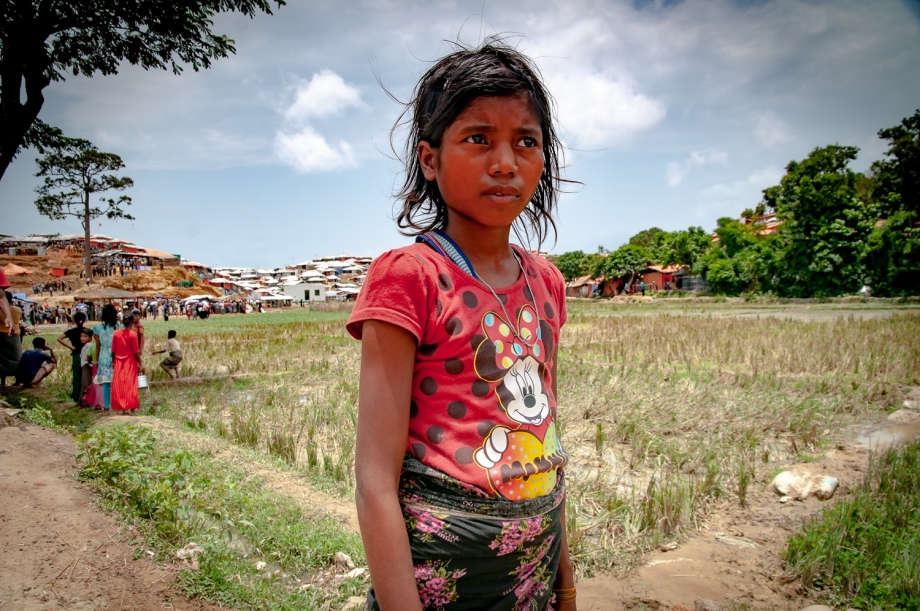

A Rohingya girl stands on the fringe of the world's largest refugee camp, known as the Balukhali-Kutapalong expansion site. In 2017 more than 730,000 Rohingya, mostly Muslim, were forced out of Burma and into neighboring Bangladesh. This was a huge and unprecedented exodus, where the newer Rohingya refugees joined some 250,000 Rohingya that over the previous 15 to 20 years had fled Burma and established themselves in far eastern Bangladesh. Some 13 camps have evolved, with approximately 1 million Rohingya refugees effectively declared 'stateless' by the military government in Burma.
The indigenous Rohingya people traditionally lived in the region comprised of Rakhine State, in Burma, and several large districts in eastern Bangladesh, including Cox's Bazaar, Chittagong, and Bandarban districts. The Burmese government has revoked their citizenship and declared them occupiers and land-grabbers claiming that they all historically lived in Bangladesh, though there is a long and well-documented history of the Rohingya's traditional ethnocultural history on both sides of the international boundary delineated in the colonial era.
Make Comment/View Comments
Additional Credits
Video
Photographer Statement
This project involved many people whose courage, resilience, kindness and determination cannot be overstated. Some of the names are changed, some redacted, to protect them from possible targeting by agents of the Burmese government. Along with the images of survivors I have gathered testmonials about the vioelnce, including dates of military operations, and the results of them; forensice evidence; the dates and places where atrocities occurred, and sometimes the names, ranks, or official positions of some of the perpetrators of atrocities.
License
To license this work for editorial, creative, or other uses, click on the OZMO logo above.
This will take you to the Ozmo website retro toys where you can review the cost and license for the photographs in this exhibit.
You will need to create an account with both Amazon payments and with the Ozmo website as described on the Ozmo website.
Tags
Content loading...
Resources
Affiliated NGO
Contact Photographer
Stats
Rohingya: We Prefer to Call it Burma
keith harmon snow | Cox's Bazaar, Bangladesh
Photographer: keith harmon snow
Exhibit Title: Rohingya: We Prefer to Call it Burma
Location: Cox's Bazaar, Bangladesh
"We Prefer to Call it Burma" examines the plight of 'stateless' Rohingya refugees trapped in the Cox's Bazaar and Tecnaf districts of Bangladesh. Many Rohingyas call their country Burma, rejecting Myanmar (assigned by the military in 1989).
Photographs depict conditions in the camps, and provide documentary evidence and testmonials of genocide committed against Rohingya people by the Burmese military. They also juxtapose and situate the Rohingya in relation to the host community and surrounding areas.
Some one million Rohingyas struggle to survive in heavily popluated Bangladesh. This has caused conflict with Bangladeshis, esp. due to the uneven distribution of resources by the charity & aid complex. As more resources are depleted by the joint populations, these problems continue to grow.
Violence in Burma continues. Rohingyas are being trafficked out of the camps�"and fleeing Burma by boat�"sometimes trapped at sea, held ransom, or killed. Talk is cheap and ubiquitous, but there has been little substantive international action or committment to truly help the Rohingya people.
As of May 5, 2020, CIVID-19 had no substantive impact on the Rohingya refugee camps.
"We Prefer to Call it Burma" examines the plight of 'stateless' Rohingya refugees trapped in the Cox's Bazaar and Tecnaf districts of Bangladesh. Many Rohingyas call their country Burma, rejecting Myanmar (assigned by the military in 1989).
Photographs depict conditions in the camps, and provide documentary evidence and testmonials of genocide committed against Rohingya people by the Burmese military. They also juxtapose and situate the Rohingya in relation to the host community and surrounding areas.
Some one million Rohingyas struggle to survive in heavily popluated Bangladesh. This has caused conflict with Bangladeshis, esp. due to the uneven distribution of resources by the charity & aid complex. As more resources are depleted by the joint populations, these problems continue to grow.
Violence in Burma continues. Rohingyas are being trafficked out of the camps�"and fleeing Burma by boat�"sometimes trapped at sea, held ransom, or killed. Talk is cheap and ubiquitous, but there has been little substantive international action or committment to truly help the Rohingya people.
As of May 5, 2020, CIVID-19 had no substantive impact on the Rohingya refugee camps.
This project involved many people whose courage, resilience, kindness and determination cannot be overstated. Some of the names are changed, some redacted, to protect them from possible targeting by agents of the Burmese government. Along with the images of survivors I have gathered testmonials about the vioelnce, including dates of military operations, and the results of them; forensice evidence; the dates and places where atrocities occurred, and sometimes the names, ranks, or official positions of some of the perpetrators of atrocities.
Content loading...
Make Comment/View Comments

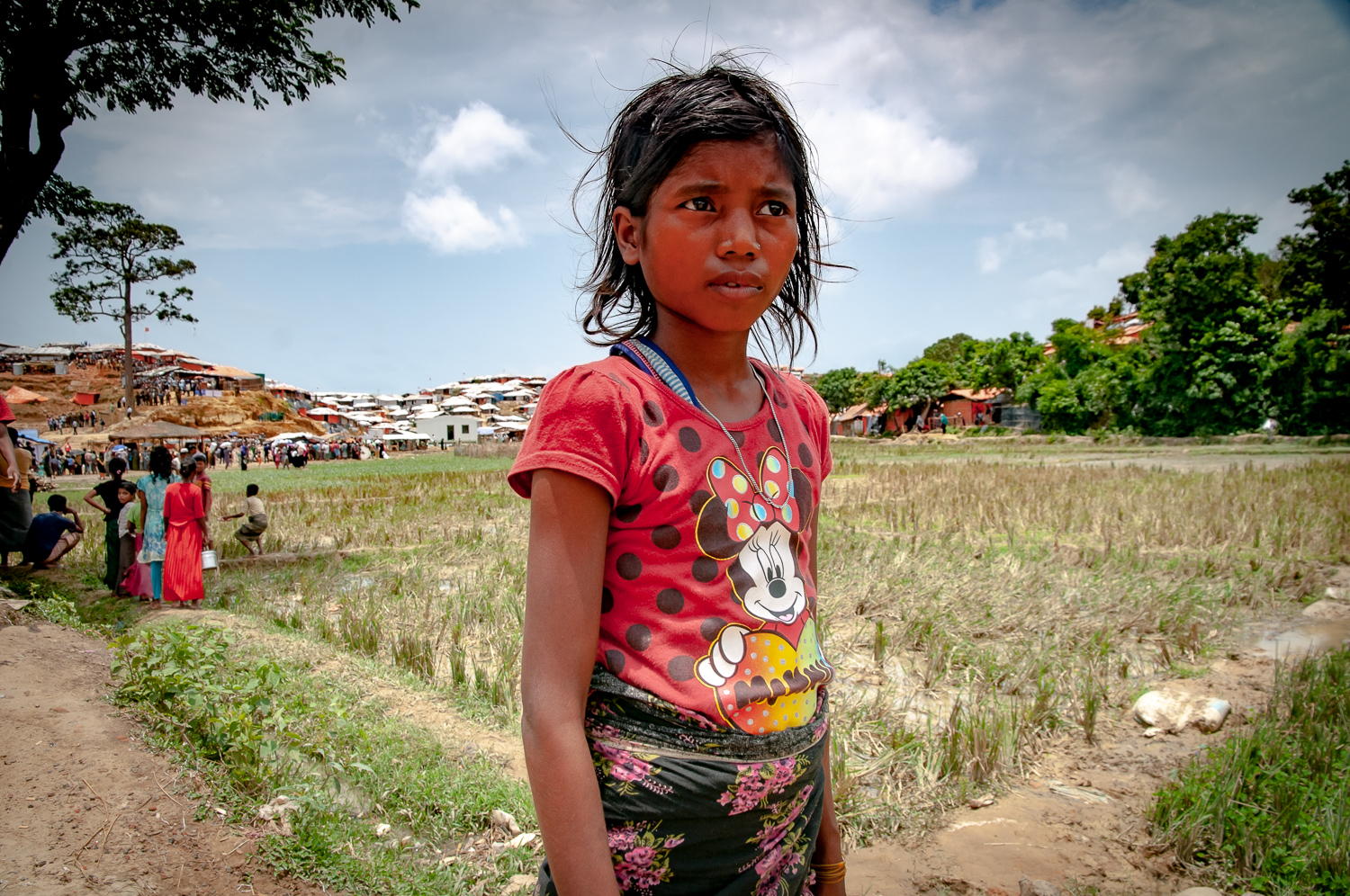
A Rohingya girl stands on the fringe of the world's largest refugee camp, known as the Balukhali-Kutapalong expansion site. In 2017 more than 730,000 Rohingya, mostly Muslim, were forced out of Burma and into neighboring Bangladesh. This was a huge and unprecedented exodus, where the newer Rohingya refugees joined some 250,000 Rohingya that over the previous 15 to 20 years had fled Burma and established themselves in far eastern Bangladesh. Some 13 camps have evolved, with approximately 1 million Rohingya refugees effectively declared 'stateless' by the military government in Burma. The indigenous Rohingya people traditionally lived in the region comprised of Rakhine State, in Burma, and several large districts in eastern Bangladesh, including Cox's Bazaar, Chittagong, and Bandarban districts. The Burmese government has revoked their citizenship and declared them occupiers and land-grabbers claiming that they all historically lived in Bangladesh, though there is a long and well-documented history of the Rohingya's traditional ethnocultural history on both sides of the international boundary delineated in the colonial era.
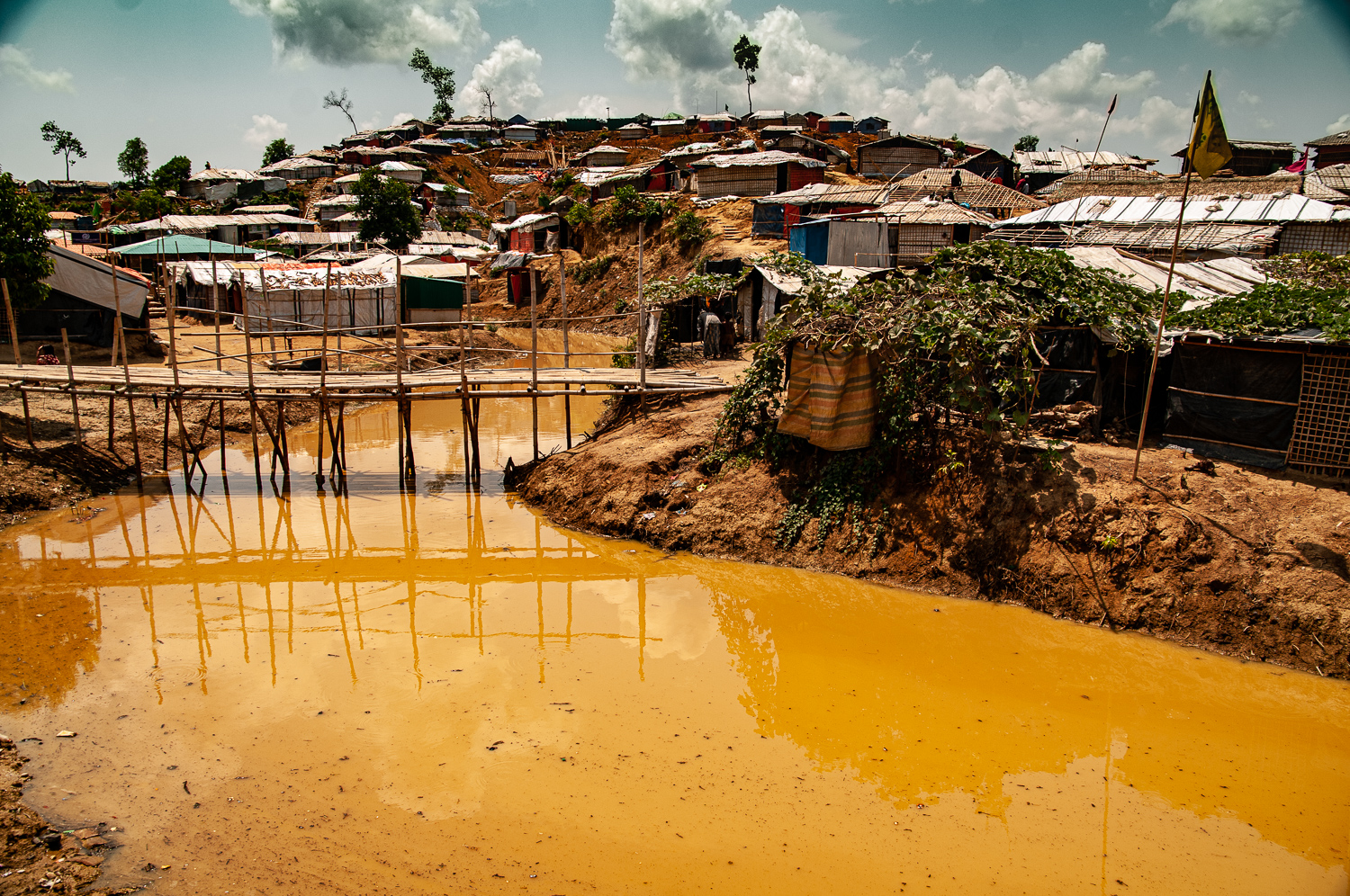
The monsoon season in Bangladesh (Southeast Asia) brings heavy rains and high winds, electrical storms, frequently evolving into typhoons, cyclones or hurricanes. The Rohingya refugee camps like this one, Balukhali, evolved on geographical terrain that was formerly heavily forested with tropical species: large dipterocarps, mahogany, bamboos and palms. The high rate of influx and large refugee population density—with the people's concomitant desperate struggle for survival (food, firewood, shelter)—caused the forests to be denuded of most all vegetation, creating steep hills that become treacherous and muddy, with high potential for landslides, and ravines that quickly and dangerously flood.
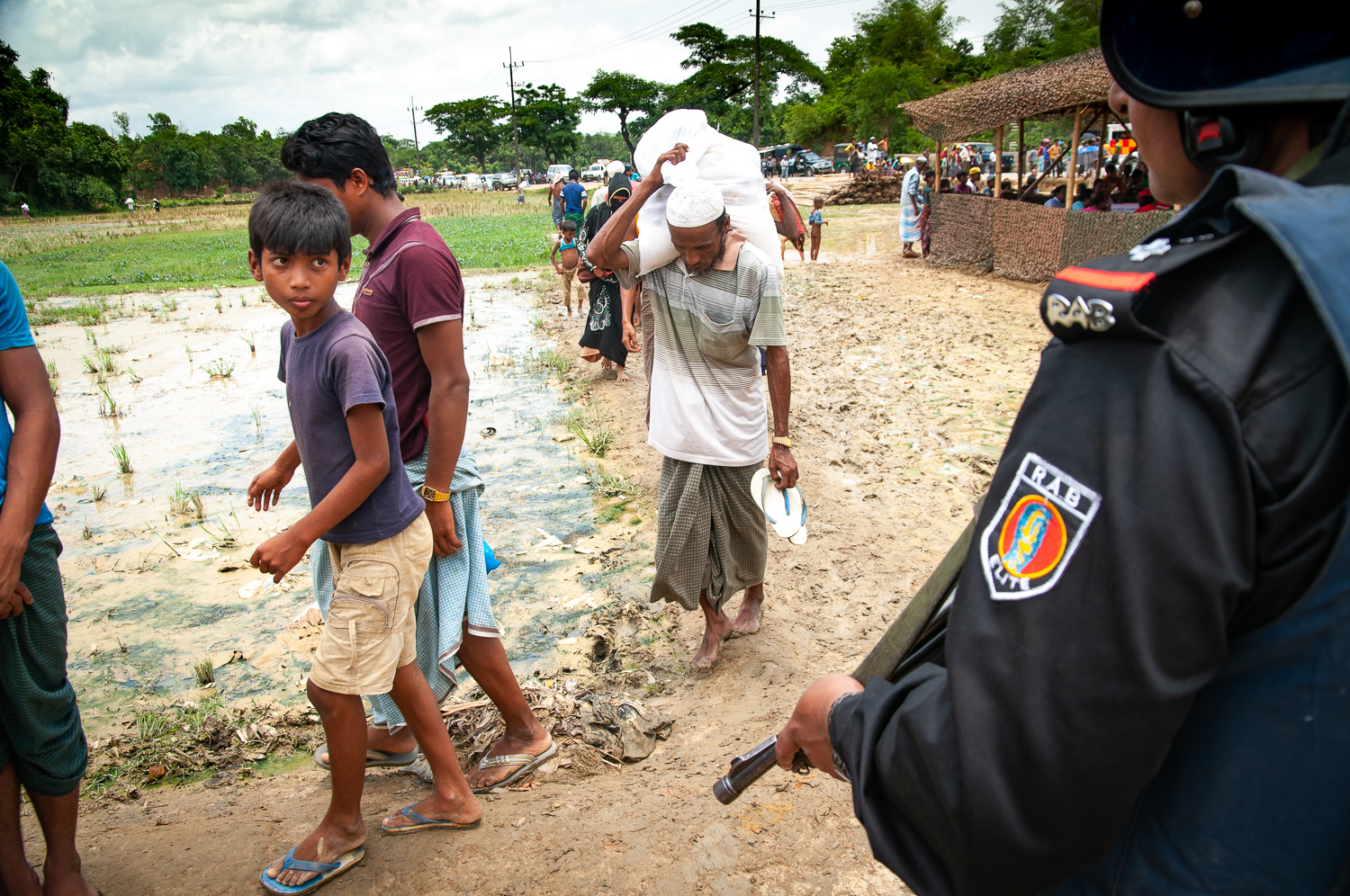
A Rohingya child casts a curious glance at a soldier of the Bangladesh Special Forces (RAB) who is standing guard, with sub-machine gun, during a special disaster-preparedness exercise at the Balukhali refugee camp. The Bangladesh army got involved in the Rohingya situation very early, providing many soldiers to manage and register all the refugees. Many of the Bangladesh soldiers are themselves suffering, due to low salaries, authoritarianism, poverty and lack of education. The Rapid Action Battalion (RAB) is the Bangladesh army's special forces branch that is known for committing serious abuses against the Bangladesh population.
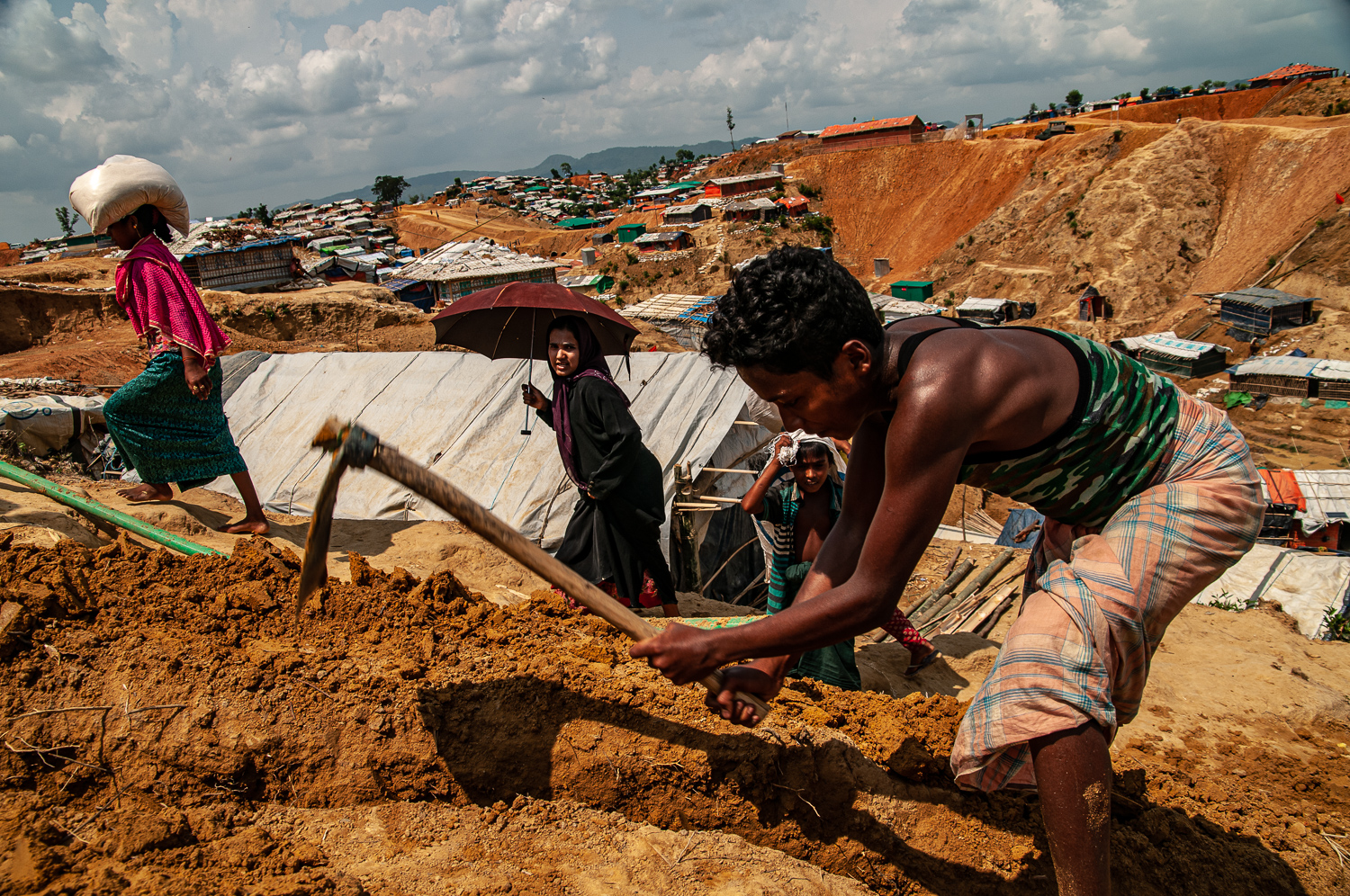
A young Rohingya man (16) working under the scorching hot sun on a steep deforested hillside of the Balukhali camp uses a Bangladesh pick-adze to cut a channel in advance of the imminent monsoon rains. Fear of landslides was widespread, and remains so, as many of the Rohingya refugees continue to reside in substandard rudimentary shelters made of bamboo and plastic tarps, many of which were erected hastily and on steep inclines (in any case). The week of 14-18 May, 2018, a minor landslide due to a cyclone killed five Rohingya refugees. In May of 2017—prior to the massive Rohingya refugee influx of August and September 2017—typhoon Mora battered coastal villages of the Cox's Bazaar district, killing at least six people, and completely destroyed more than 10,000 huts in the Balukhali-Kutapalong refugee camp.
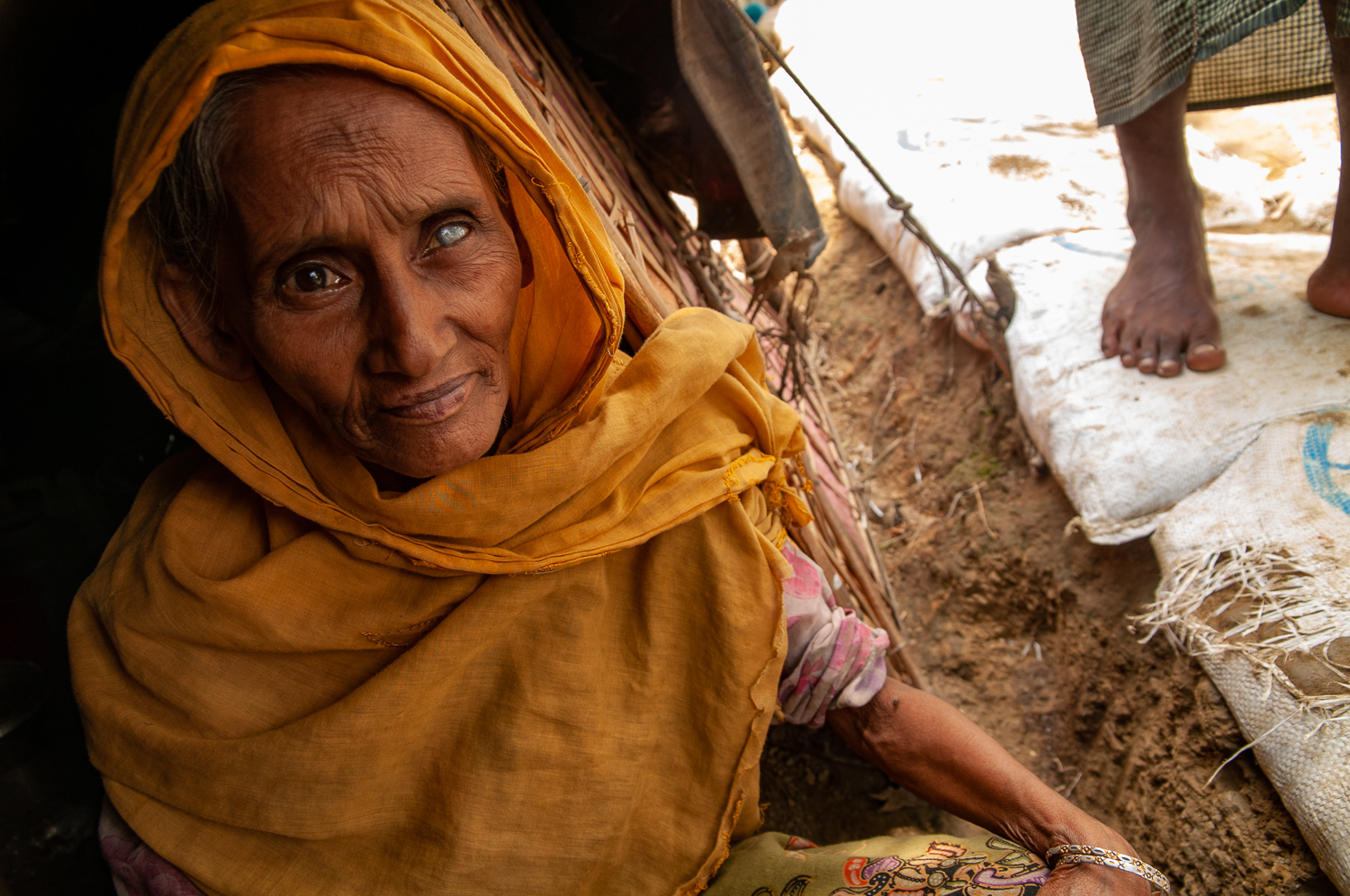
A Rohingya elder, another survivor of genocide, spends what she expects will be her last days resting in a bamboo hut at the Uchiprang refugee camp, 15 May 2018. Her husband was killed by the army at Hascharbil village, in Burma's Rakhine State. She fled the genocidal violence, arriving in Bangladesh in September 2017. She is worried about landslides. "We have cried so much in the last 9 months," she said. "Many [women] saw their husbands killed by [the Burmese army] slitting their throats."
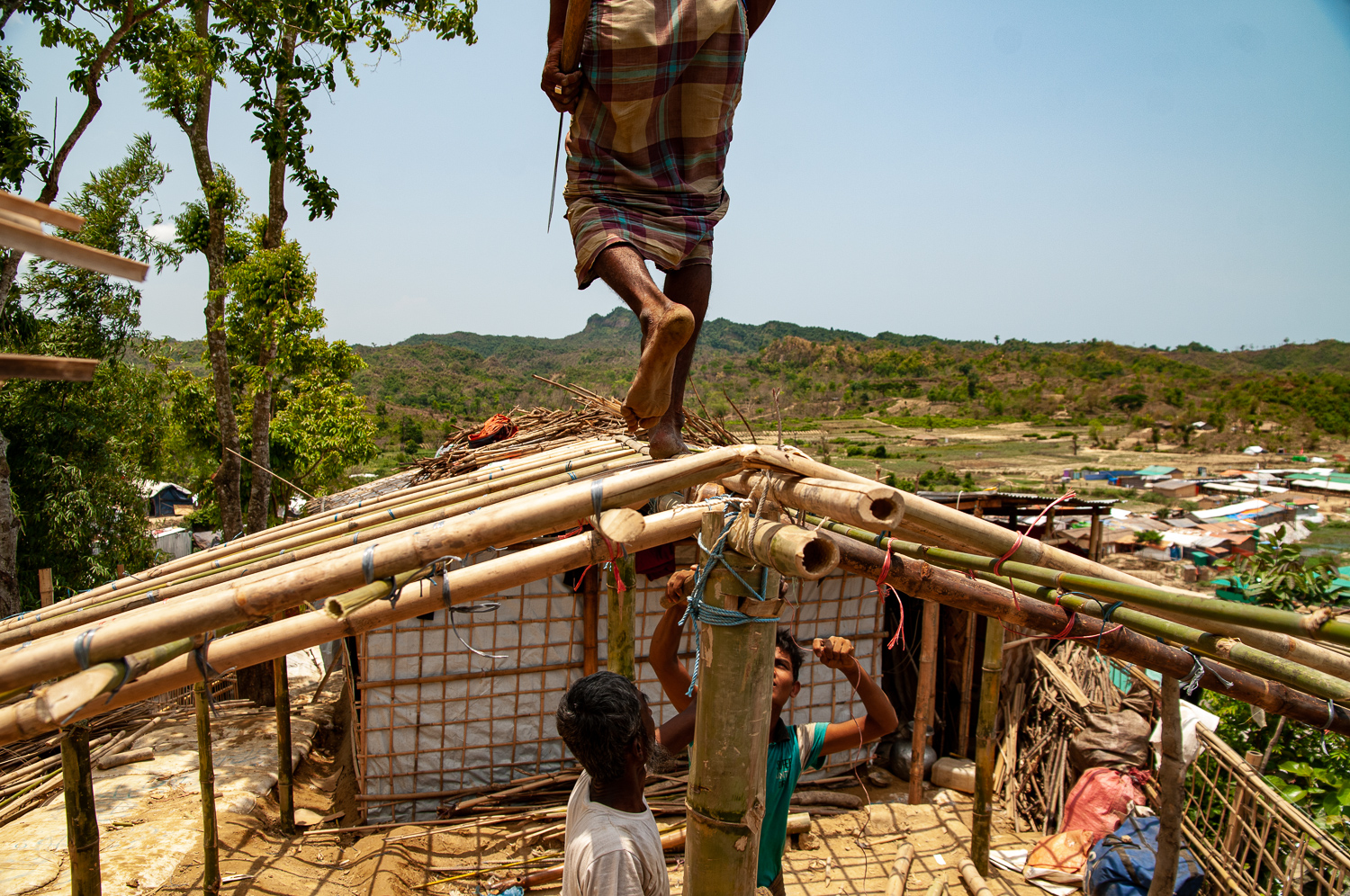
Rohingya men from different families living in (assigned to) the Uchiprang refugee camp, join forces to rebuild a shelter (hut) destroyed by high winds in May 2018. Huts are weak, built with a lightweight bamboo, lashed with a light cordage, tarped with plastic, the floors usually only dirt.
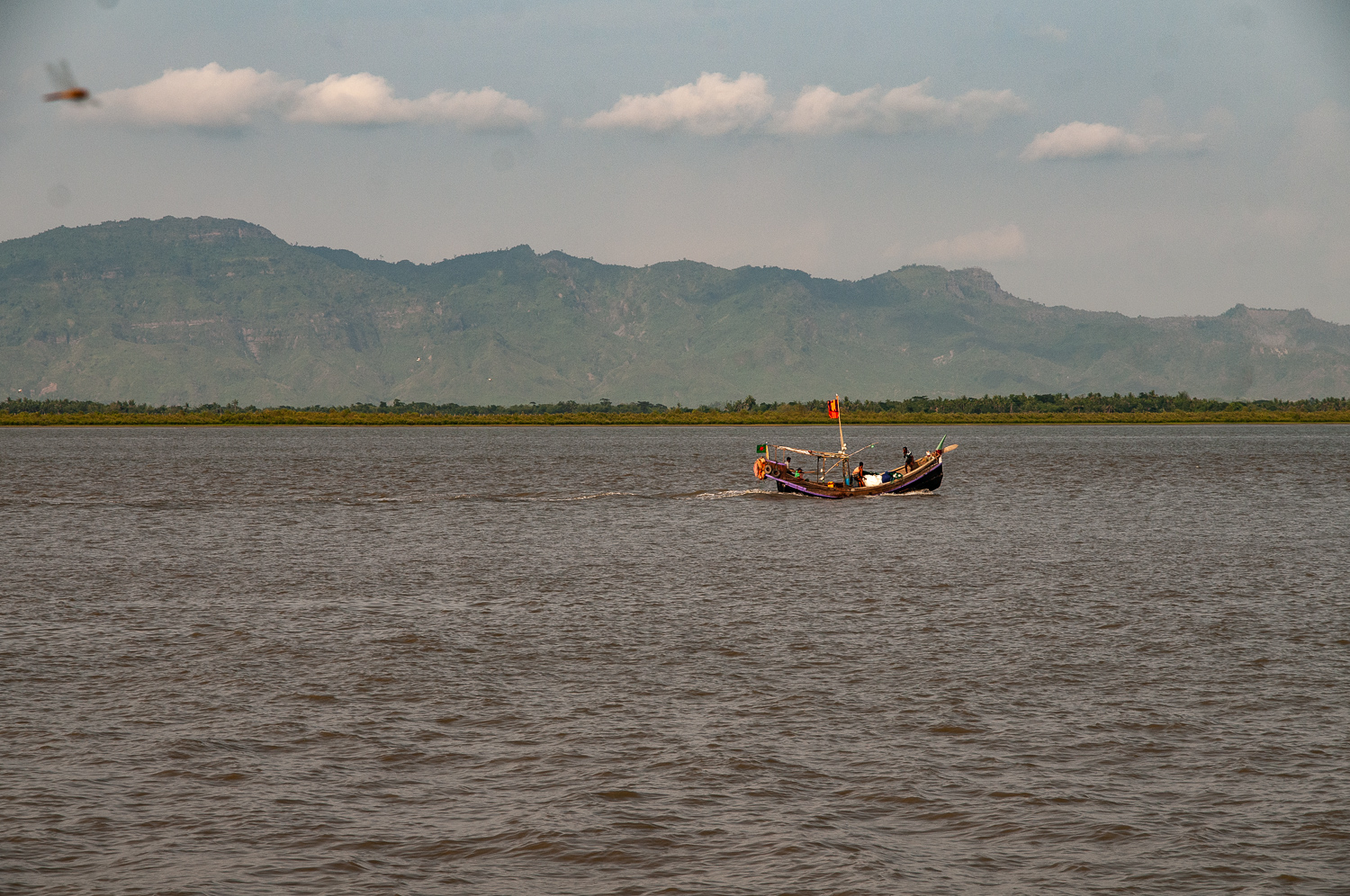
A fishing vessel—heading out to sea—navigates the Naf River just off the coast of the Maungdaw district of Burma's Rakhine State. Maungdaw was the site of massive genocidal violence, with widespread atrocities and scorched earth destruction of villages committed against the Rohingya by the Burmese military. Many Rohingya were forced to flee to the shores of the Naf River and seek some kind of transport out of Burma. The closest prospect was the Cox's Bazaar district of Bangladesh, just across the Naf River, but many Rohingya have been forced further adrift at sea, eventually landing in Malaysia, central or western Bangladesh, eastern India. The Naf River's average depth is 128 feet (39 m), and maximum depth is 400 feet (120 m). Some Rohingya have been forced to swim across the Naf River, others subject to extortion by brokers demanding high fees.
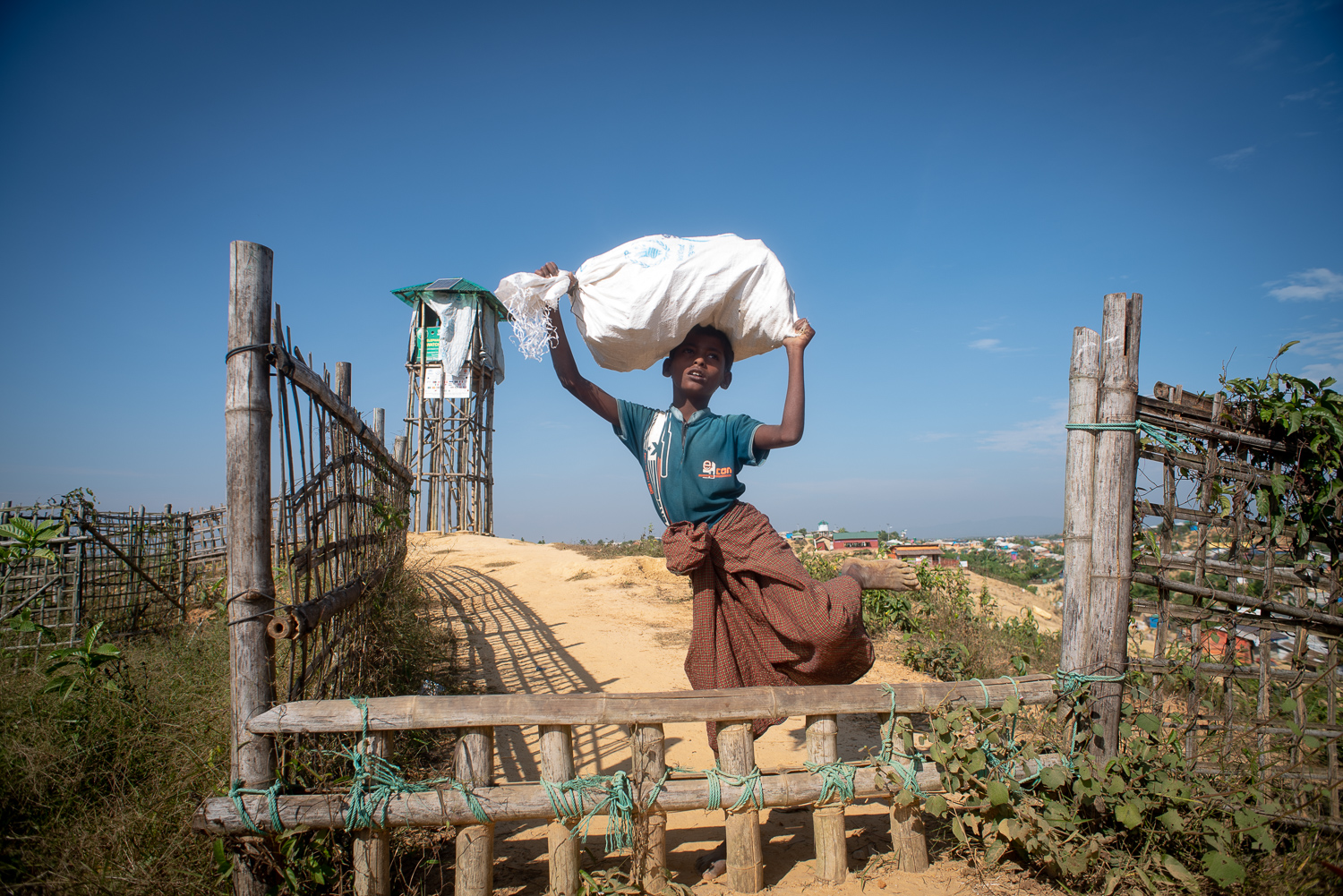
December, 2019: A Rohingya boy carries a sack of provisions over the peak of a hill at Camp 13, the southernmost Rohingya refugee camp in the Cox's Bazaar district. The tower in the background is an 'elephant watch tower' constructed to enable volunteer sentries to hold overnight vigils on watch for elephants coming out of the forest. Wild elephants have encroached on the camp, destroying huts and terrorizing residents: in 2018 a 15 year-old boy was trampeled and killed by a wild elephant.
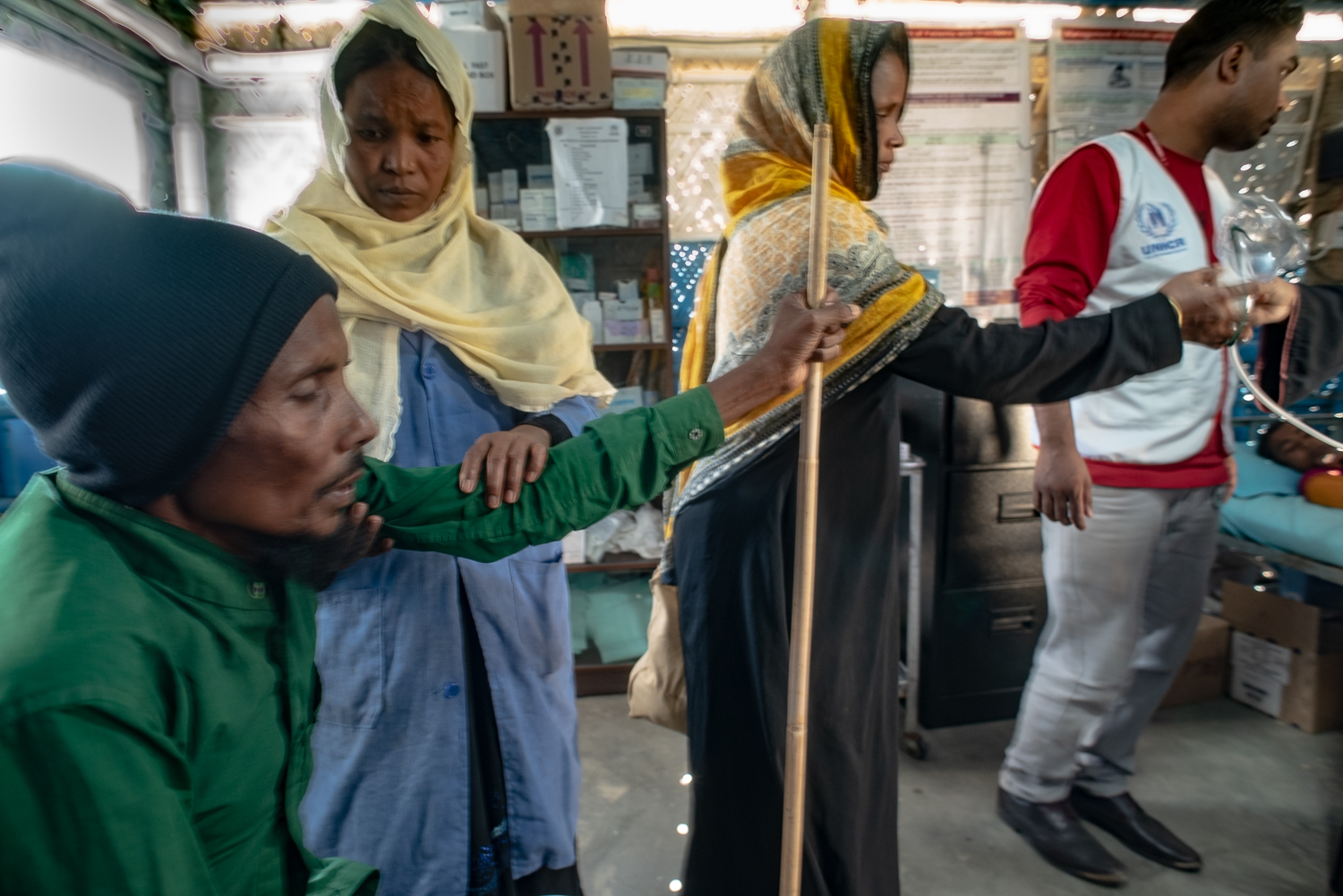
A Rohingya man suffering chronic illness has just arrived at a clinic, rushed there on the arms of two very alarmed and distraught looking female family members. The doctors quickly put him on oxygen and an intravenous IV drip.
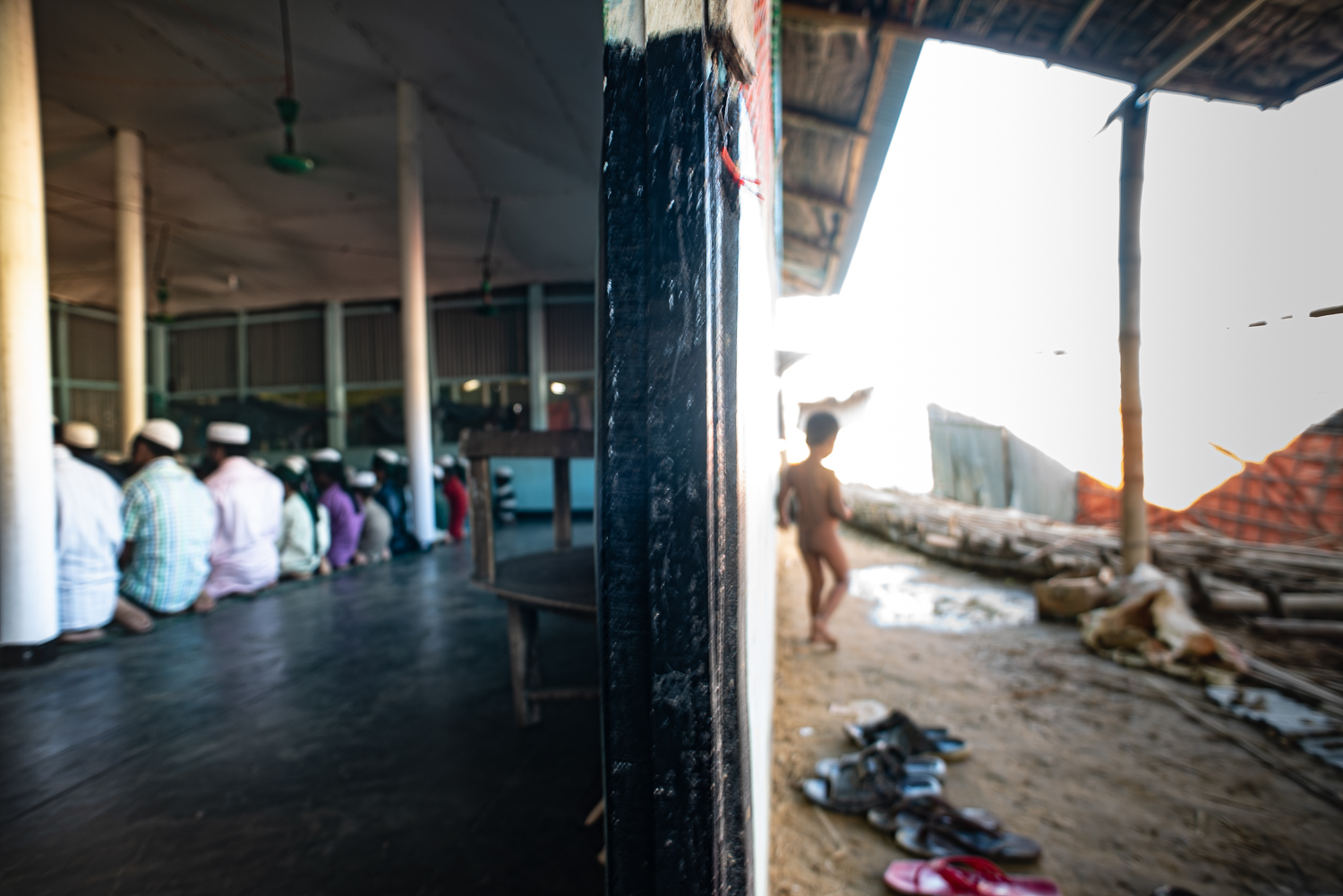
Refugee life and death often revolves around 'walls' and 'borders' and 'fences'. Inside, Rohingya men observe Muslim prayers at a small localized mosque they built, one of many constructed in the various diffuse 'neighborhoods' of the Balukhlai-Kutapalong expansion site. Outside, a naked child wanders around looking for something or someone to play with.
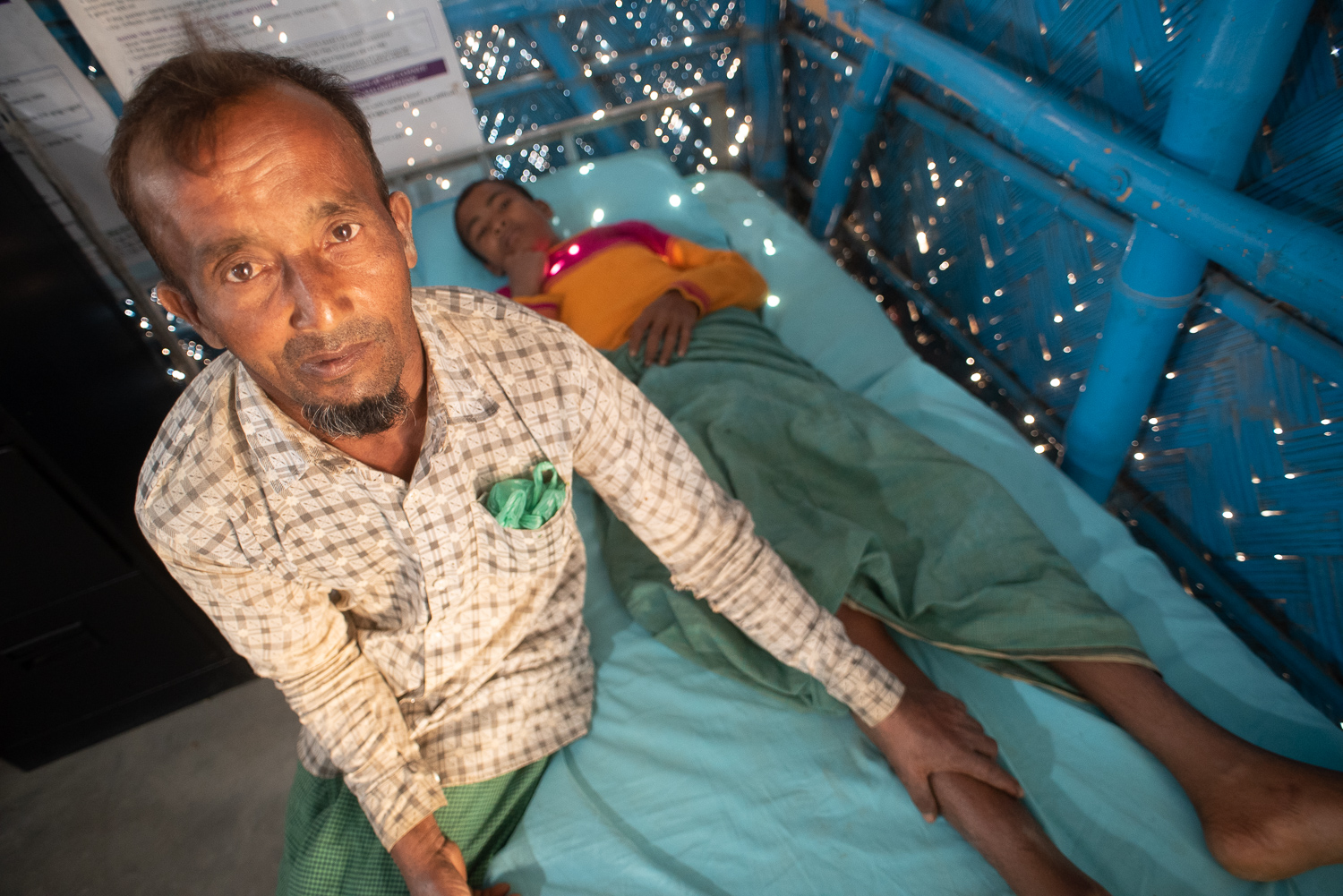
A Rohingya father implores a foreign journalist to offer support for his ailing son. The father stays with his son, offering a comforting touch, while doctors of a camp NGO try to determine the cause of illness and possible course of treatment.
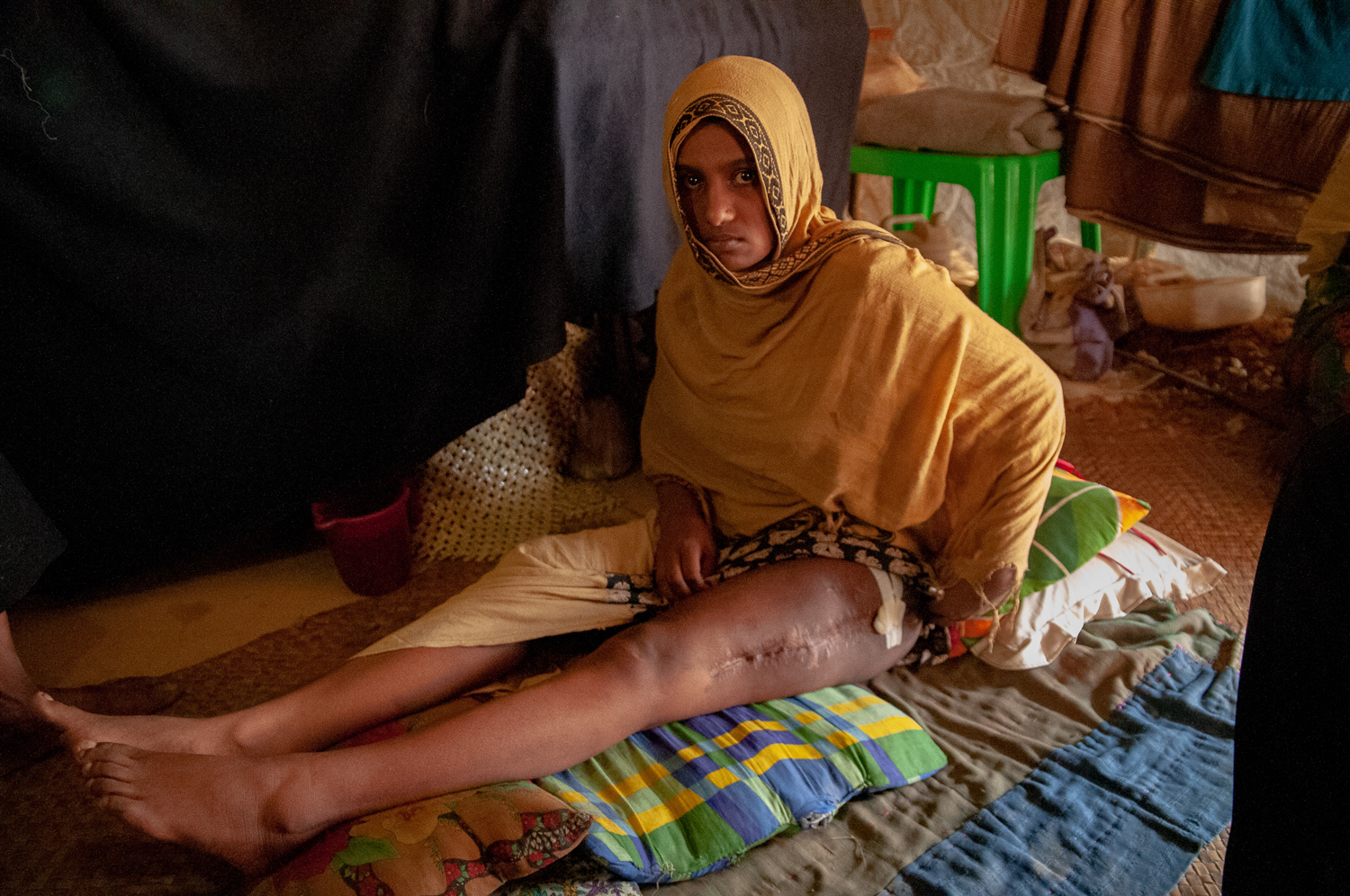
May, 2018, Rohingya teenager Khaleda Begem (16) reveals the scar that remains after a series of operations where large steel rods were inserted in her thigh to help fuse and heal her left femur bone, shattered by two bullets. She was four months in different hospitals in Bangladesh; she arrived at Balukhali II refugee camp in March 2018. Khaleda Begem was born in Balukhali, Moulajjosgar, Rakhine State, Burma, 2002, and she lived there for 16 years. She is afraid to talk to a westerner, but she tells her story. "I was shot three days before the Muslim festival of Eiduladha," in August 2017, she says. At 7:30 pm maybe 100 Burmese soldiers came to the village, during the [6 pm to 6 am] curfew, she says, near Isha [prayer time for Muslims], and they beat people with their guns. Then they took them into a big house (also used as a mosque), with some 150 other Rohingya people, and then they torched the house with all the people in it. Some people got out. She and her brother (19) and her mother escaped. Her mother, Zorina Khatun (40), was shot in the scapula.
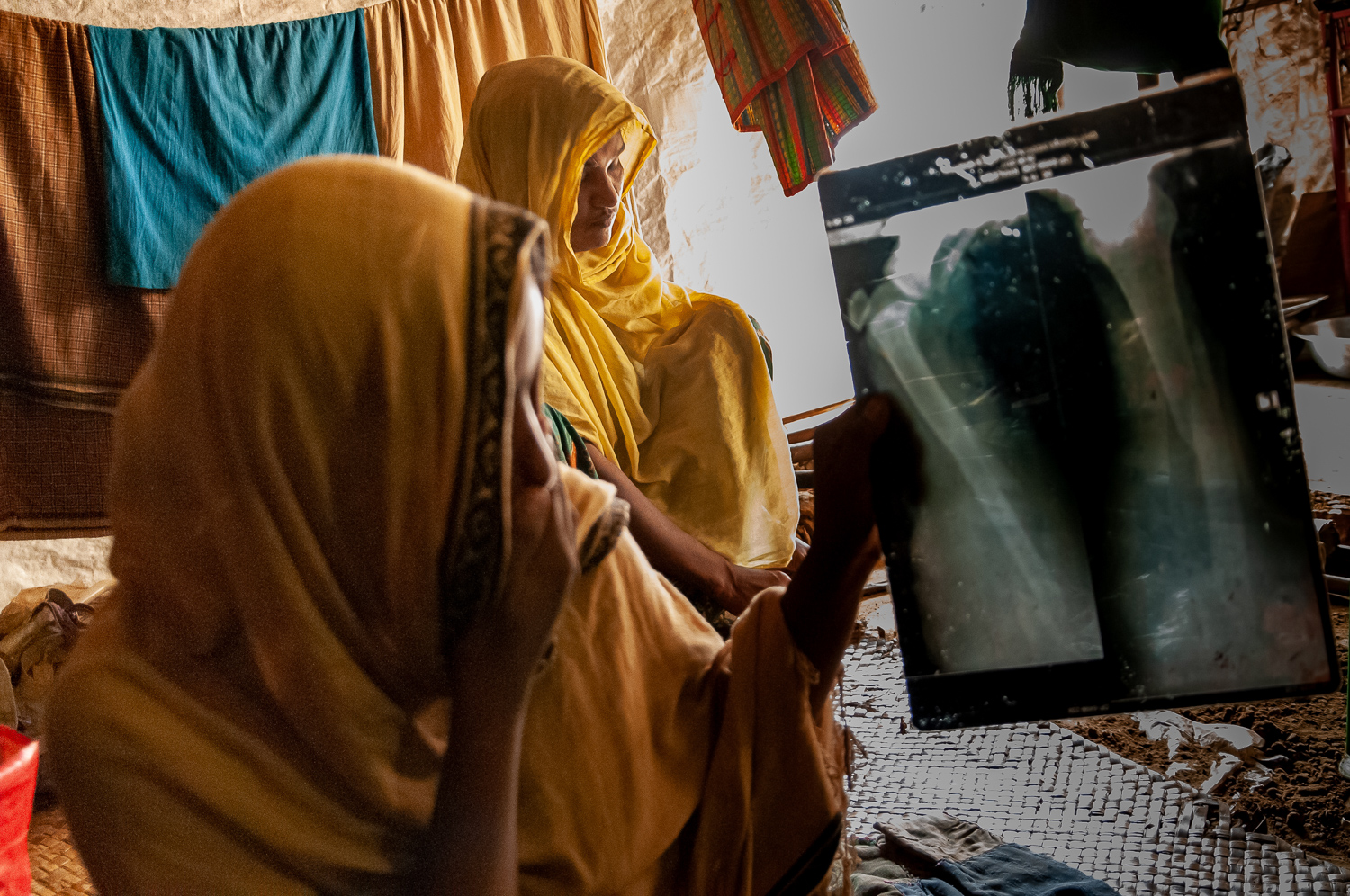
Khaleda Begem holds up the x-rays showing her shattered femur. She was shot twice in the leg while running from the building that the Burmese army torched with some 150 people inside. Her mother, Zorina Khatun (40), sits in the background offering support for Khaleda to tell her story; and later, Zorina shows the scars from the bullet wound on her back, and the scar where a soldier slashed her on the forehead with a machete. "We didn't do anything!" Khaleda Begem says. "Why do they kill adults, teenagers, even children who are one years old?" Khaleda was carried across the border, badly wounded. She and her mother recount the names of specific Buddhist monks who incited hatred and violence against the Rohingya. "I saw soldiers taking babies and cutting them and throwing them into the burning houses," she says, before they drove her and the others into the mosque and burned it.
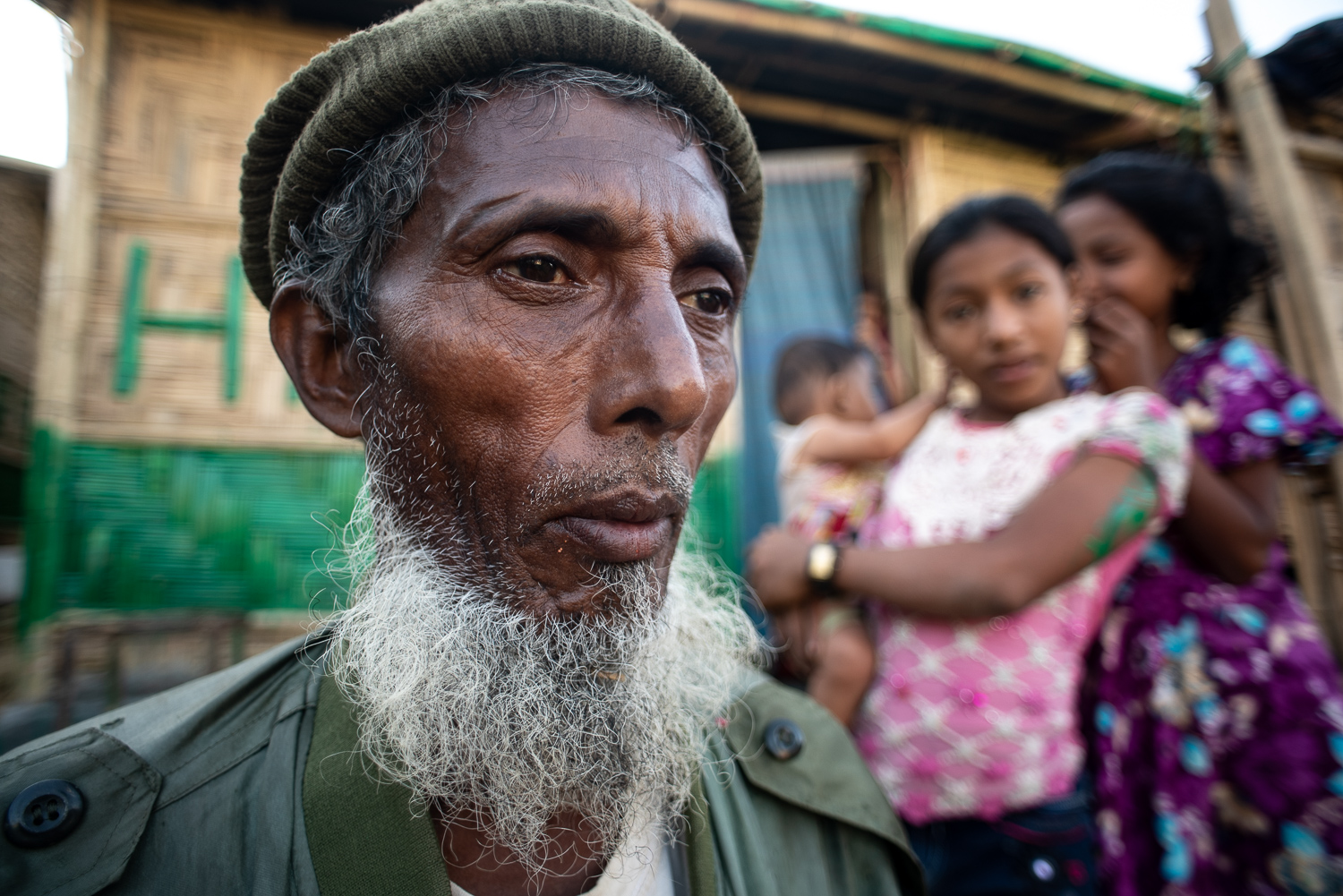
1 December 2019, Kutapalong Camp: Muhammed Salam (45) tells his story: Muhammed Salam was a landholder and all his lands in his daung (village) Yamachang were confiscated by the soldiers in 2014. He alleges that on 9 October 2016 he was beaten mercilessly by the Burmese military: they accused him of killing a pig, knocked out three of his teeth, broke his left leg, stabbed him. The military started an 'operation' on that day, he says: many villages were torched, many Rohingya killed, many women and teenage children were gang-raped by the Burmese soldiers. He reveals the scars on his body. His son was disappeared. He names generals, other commanders, and soldiers responsible for atrocities. While fleeing to Bangladesh on 25 August 2017, he and his wife witnessed over 35 Rohingya being shot at Kunshipying, a small village on the Burmese-Bangladesh frontier. He names seven victims, and their ages. He also witnessed Burmese soldiers shooting Rohingya as they tried to flee across the border at the Naf River.
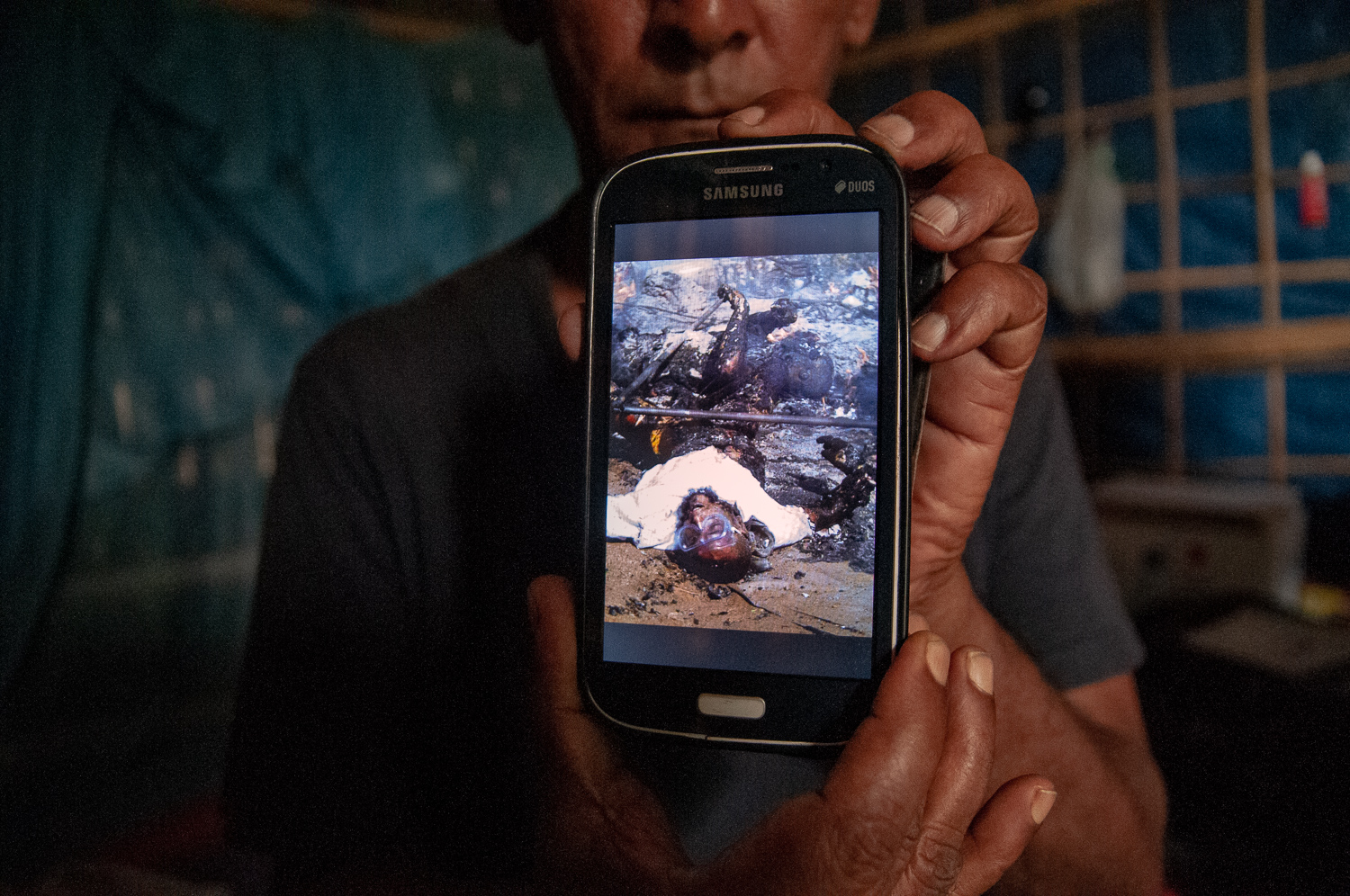
Camp 11, Bagonna Camp, 16 May 2018: 'Muhammed X' (not real name), a Rohingya survivor who requests anonymity (out of the fear of persecution) displays one of more than 60 atrocity photographs that he and a friend (a Buddhist journalist who is based in the capital city, Rangoon) compiled of the mounting human rights violations, atrocities and ethnic cleansing committed by the military against Rohingya in Burma's Rakhine State. This man is an intellectual, one of a few leading Rohingya intellectuals who escaped the violence of August through November 2017. Most of the atrocities he recorded were committed in 2017. Many Rohingya have no formal education. By November 2019, the Bangladesh government declared they would be confiscating all cell phones belonging to Rohingya refugees: the government declared that it was illegal for Rohingya to use Bangladesh Sim cards. Over the past year, the Bangladesh government has also cut all Internet connectivity. "We don't support ARSA," says 'Muhammed X', speaking of the Arakan Rohingya Resistance Army, "but there are Rohingya abroad—in Europe, USA, Canada, Australia—who provide support for Rohingya. ARSA has few weapons, and they are old. We prefer to call it Burma, not Myanmar. I don't trust or like ARSA."
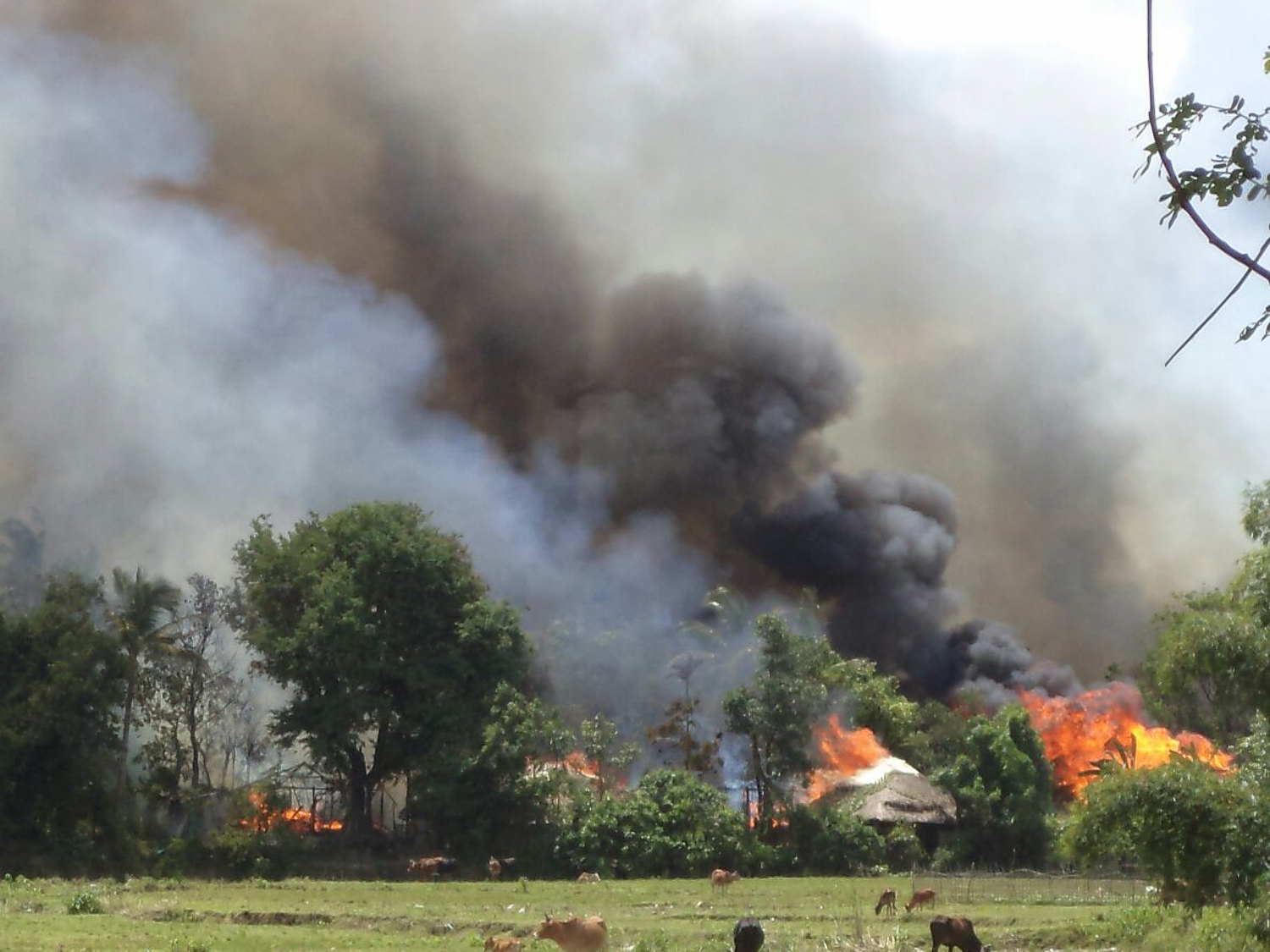
The Rohingya village of Longdung Pokhidung, set ablaze by Burmese soldiers, photographed by 'Muhammed X'. This is one of the more than 60 original atrocity photos provided by 'Muhammed X'—transferred by flash drive to a western journalist—that provide evidence of the Burmese military's targeted discrimination, persecution, and attacks against the indigenous Rohingya people, and the concomitant scorched earth destruction of Rohingya villages and the subsequent destruction of forensic evidence (e.g. bulldozing of charred remains of houses, creation of mass graves, burial of corpses). Many of the photos—mostly very low-resolution jpegs—show the horrors of the latest phases of the unfolding genocide against the Rohingya, including pictures of arson, looting, killings, bodily dismemberment. There are also pictures providing reasonable evidence of the involvement of the Burmese military, and there are a few images that purport to show Buddhist monks collaborating with the Burmese military against innocent non-combatant Rohingya people.
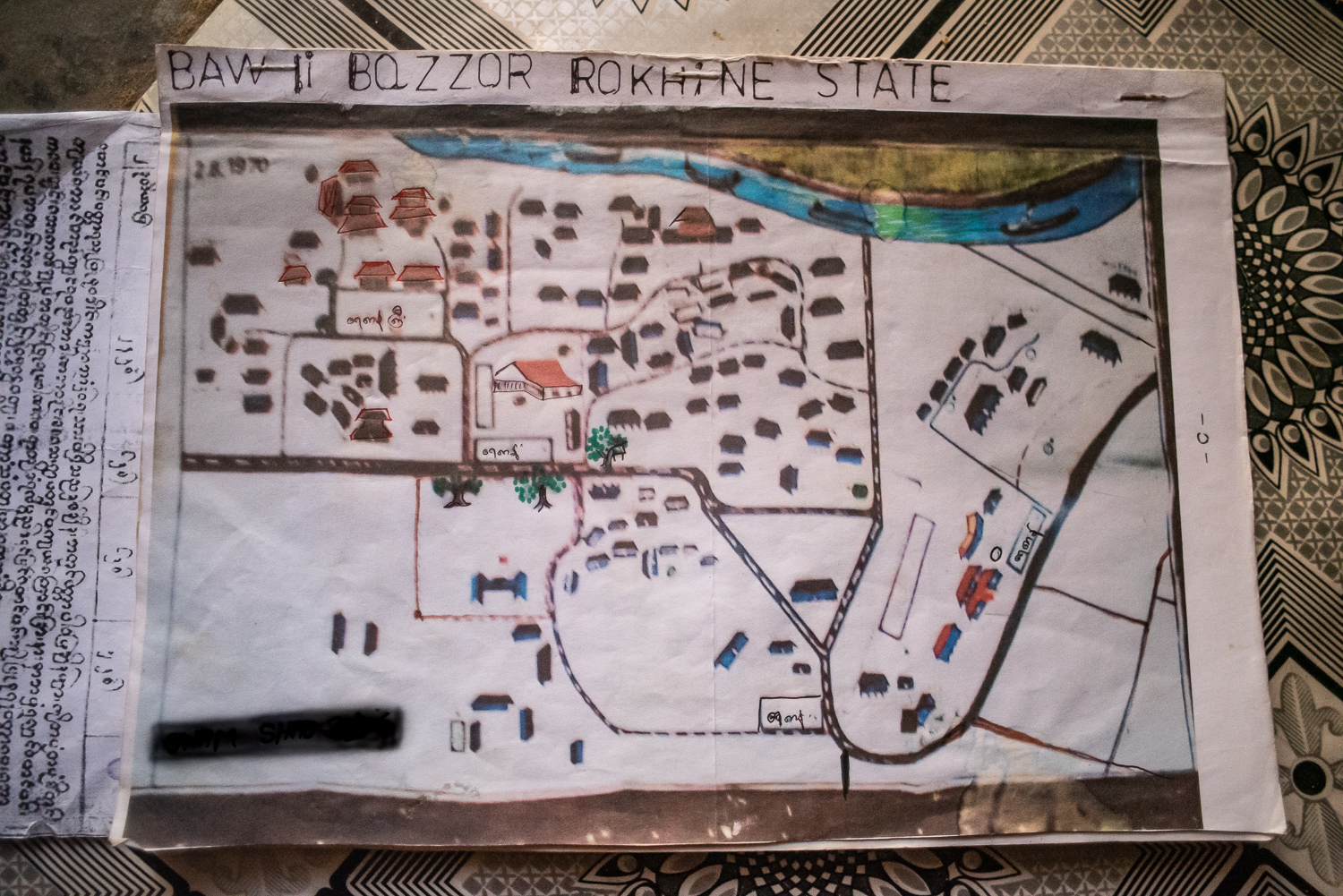
'Muhammed X' displays a primitive but accurate map of his village, Bawli Bazaar, with his home on it, that was burned to the ground by the Burmese military in late August and early September 2017. 'Muhammed X' drew this map from memory after his arrival at the Baggana refugee camp in the Cox's Bazaar District of Bangladesh on 19 September 2017. 'Muhammed X' was born in Bawli Bazaar on (date redacted), 24 miles from the hard-hit Maungdaw town, and he lived there all his life, more than 60 years. "Over the years the [Burmese] government has launched many different military-intelligence operations targeting Rohingya people," 'Muhammed X' said. Bawli Bazaar village was burned on 25 August 2017. The red-roofed building was a mosque. The blue building with the flag was a high school. Inside the triangle, a hospital. The river is Phuma Creek. The village was leveled, bulldozed to 'zero level'.
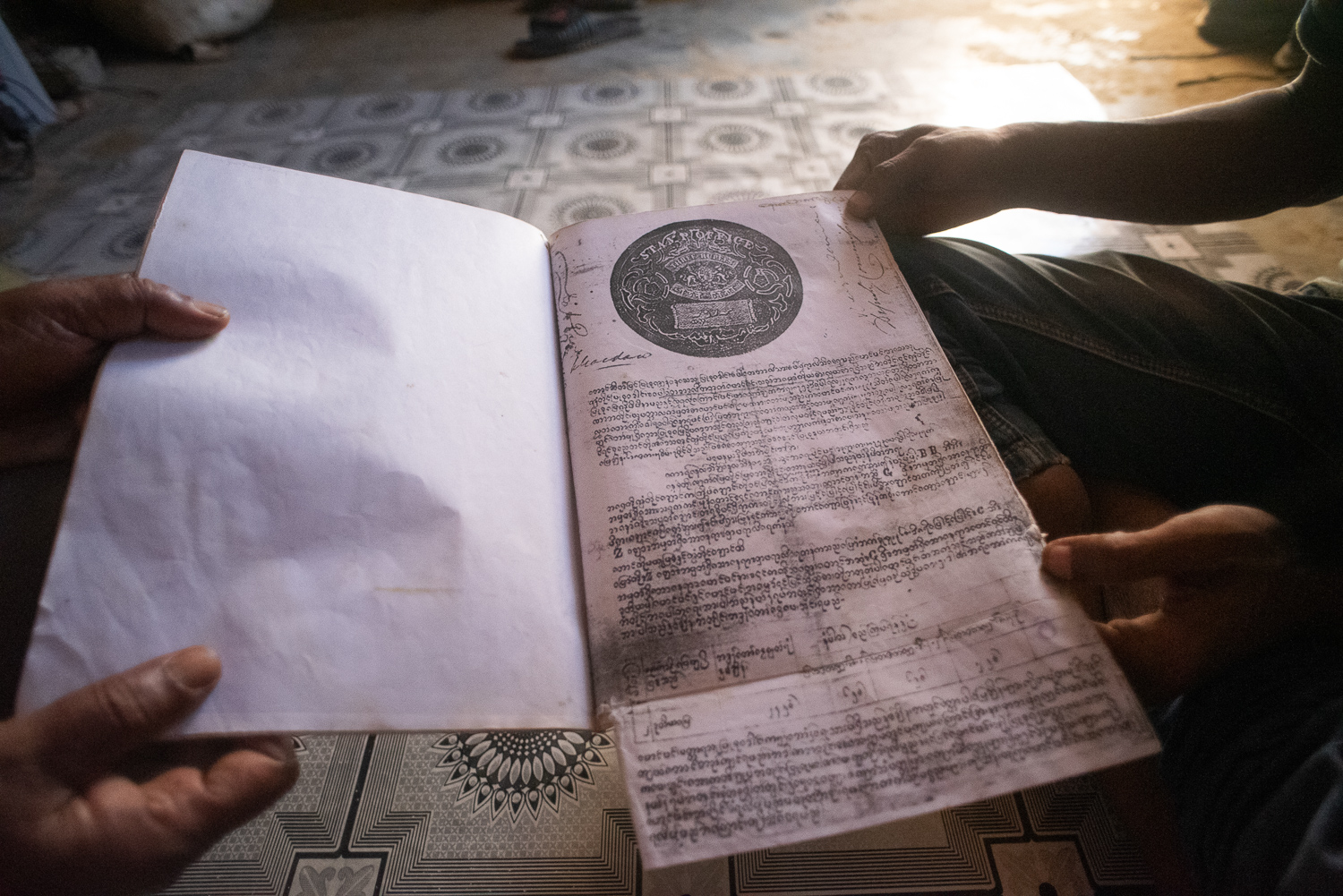
'Muhammed X' displays one of the many of his personal documents, a deed for 10 hectares of land, where his family's house was, with an official Burmese stamp from 1858, that he carried out of Burma during his exodus in 2017. "This is a deed of ownership of our land," he said. "My family has owned this land since before the British [colonial] times. We were landlords: my family leased the land to farmers who grew rice, spices, vegetables, or had cattle or other farm animals." 'Muhammed X' detailed the process of the Burmese military's usurpation and seizure of Rohingya lands, and the evolution of genocide. "They claim we have no records." Most Rohingya had few formal records or official documents, such as land titles or deeds, birth certificates, ID cards, documents that in some (any) way establish family origins or their title to and historical ownership of traditional lands. "Life under General Niguen was very good," 'Muhammed X' said. "General Niguen was in power from 1960 to 1993." "Now there are many undercover [Bangladesh] spies roaming the Rohingya camps," he said. "The NSI [equivalent to US CIA]; the DGFI [Army intelligence]; the SB—Special Branch—police; and the CID [Criminal Investigations Department]."
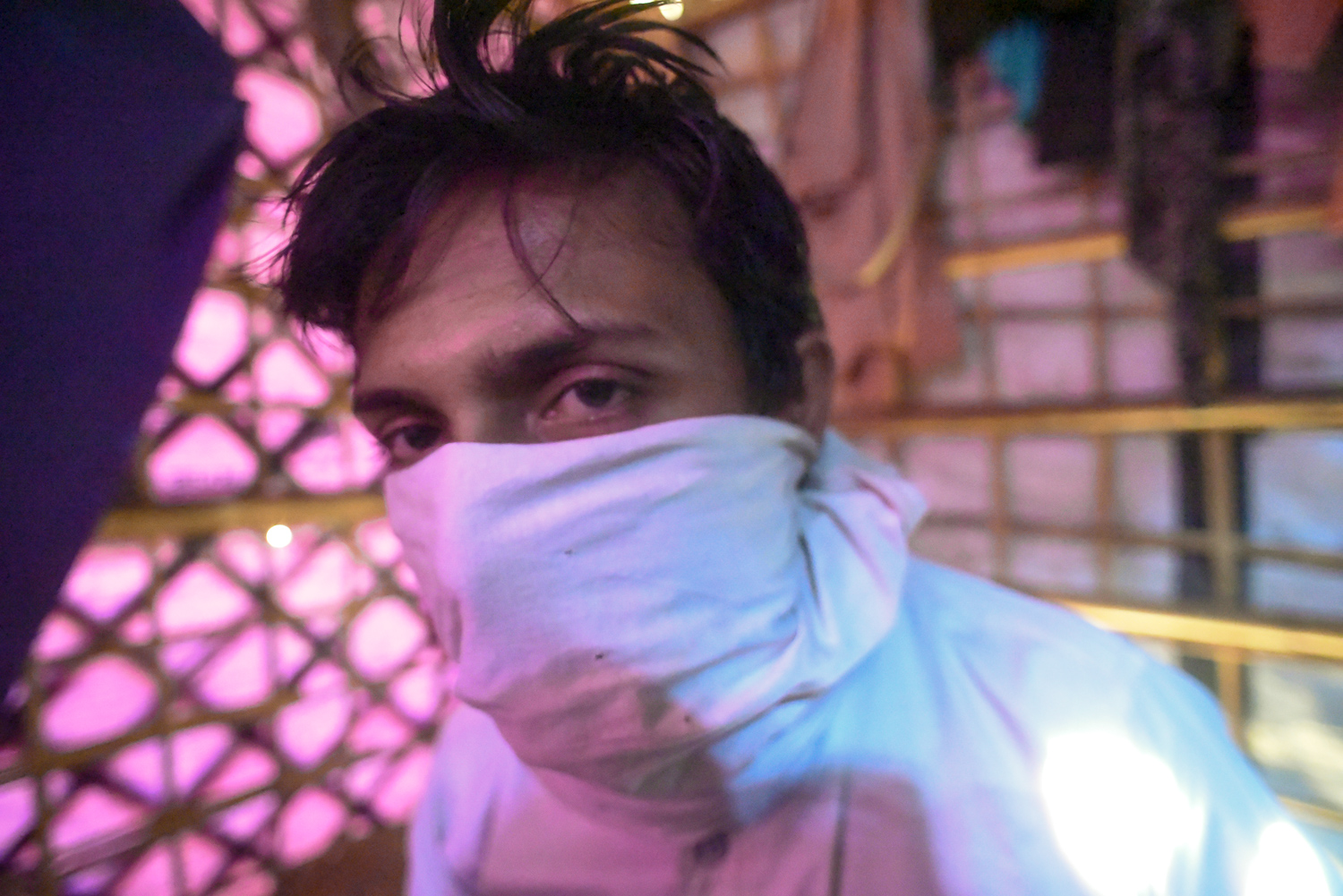
A member of the Arakan Rohingya Salvation Army (ARSA) consents to be photographed, donning a mask for anonymity, during a limited interview at the Kutapalong camp in December 2019. "I became a member of ARSA in 2012," he says. "We have a purpose. The Rohingya have been persecuted by the Burmese government for decades.That's why we decided to take up arms, to protect ur brothers and sisters, mothers and fathers. Our sisters have been raped in front of relatives, and our brothers are killed in front of villagers. We never get peace in [Burma]. So we decided to take our rights back. Rohingya have lived in Burma for centuries. We are the indigenous people of Burma." In 2016, ARSA destroyed a Burmese immigration department headquarters [called NASAKA]. ARSA allegedly killed 20 police officers and confiscated some weapons. Before this ARSA attack there was a long history of ethnic violence, random and premeditated, by the Burmese military against Rohingya. The military government points to the ARSA attack as justification for their genocidal violence, claiming ARSA are responsible for the troubles in the Rohingya community and beyond. Rohingya leaders—and ARSA—claim the Burmese military has manufactured evidence of Rohingya violence that never happened.
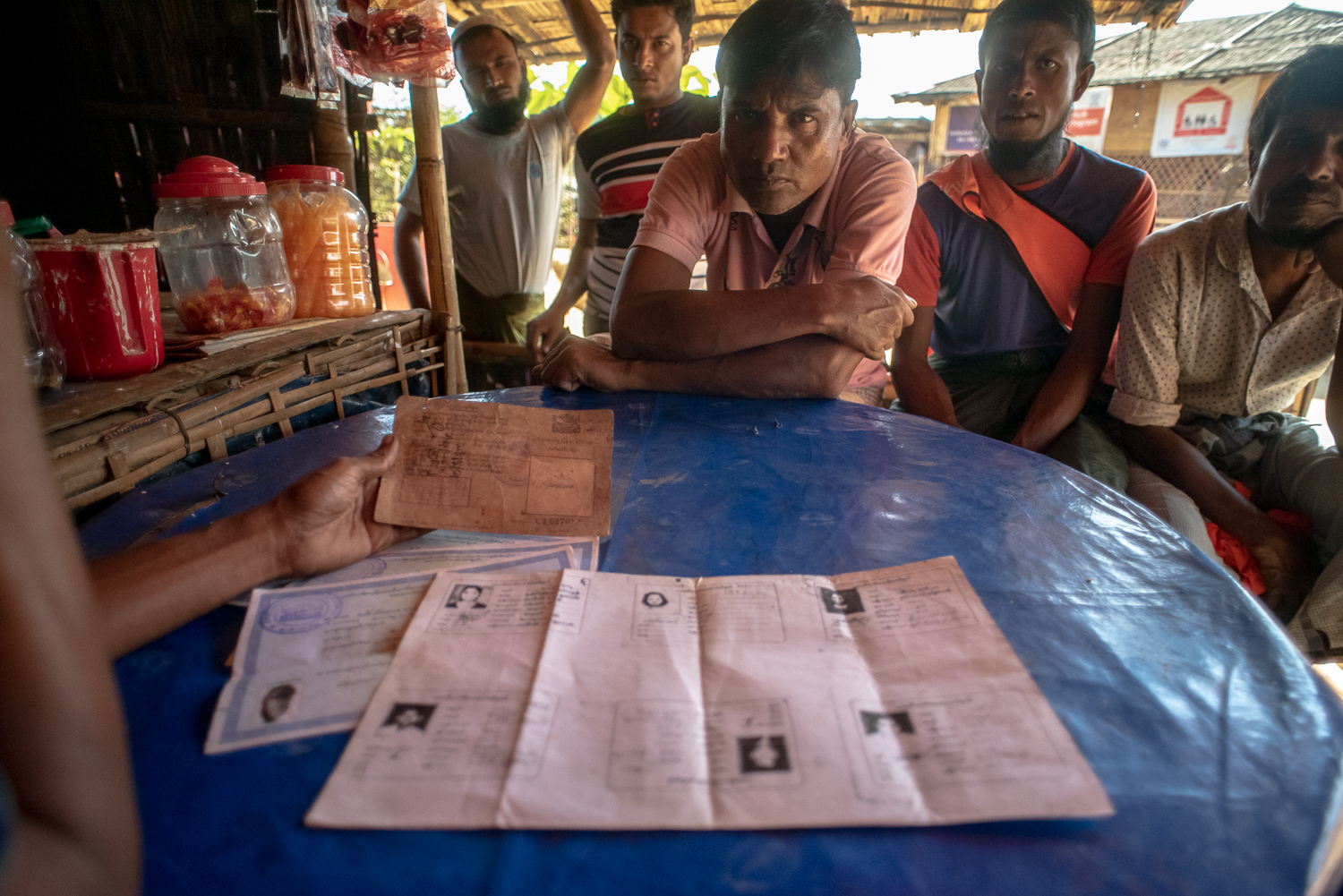
2 December 2019 Camp 13: Muhammed Wares (55) (pink shirt), Ali Muhar (40), and Noor Kobir (~27) of Bathidaung township, Rakhine State, describe the long history and patterns of violence, targeting the Rohingya, that qualify the genocidal intent of the Burmese military, including what they described as a planned policy of limiting Rohingya births. They also described personal experiences with family members being beaten, raped, killed or disappeared, starting—for them—as early as 1994. Muhammed Wares described mass rapes. They outlined the escalation of violence of August 2017, listing names/ages of people they saw killed. They claim the military and police attacked with RPGs (rocket-propelled grenades). They named the battalions that soldiers came from, names of the commanders. While crossing the border to Bangladesh they saw Rohingya being shot, people "slaughtered with knives and spears." Ali Muhar alleges he saw "about 400 Rohingya people massacred in one day": the residents of the villages of Tula Tuli and Myingyi. He fled across the border in a small boat across the Naf River. They also produced the various ID cards that establish a clear pattern of manipulation, showing how the state used ID cards to control and deny citizenship to the Rohingya.
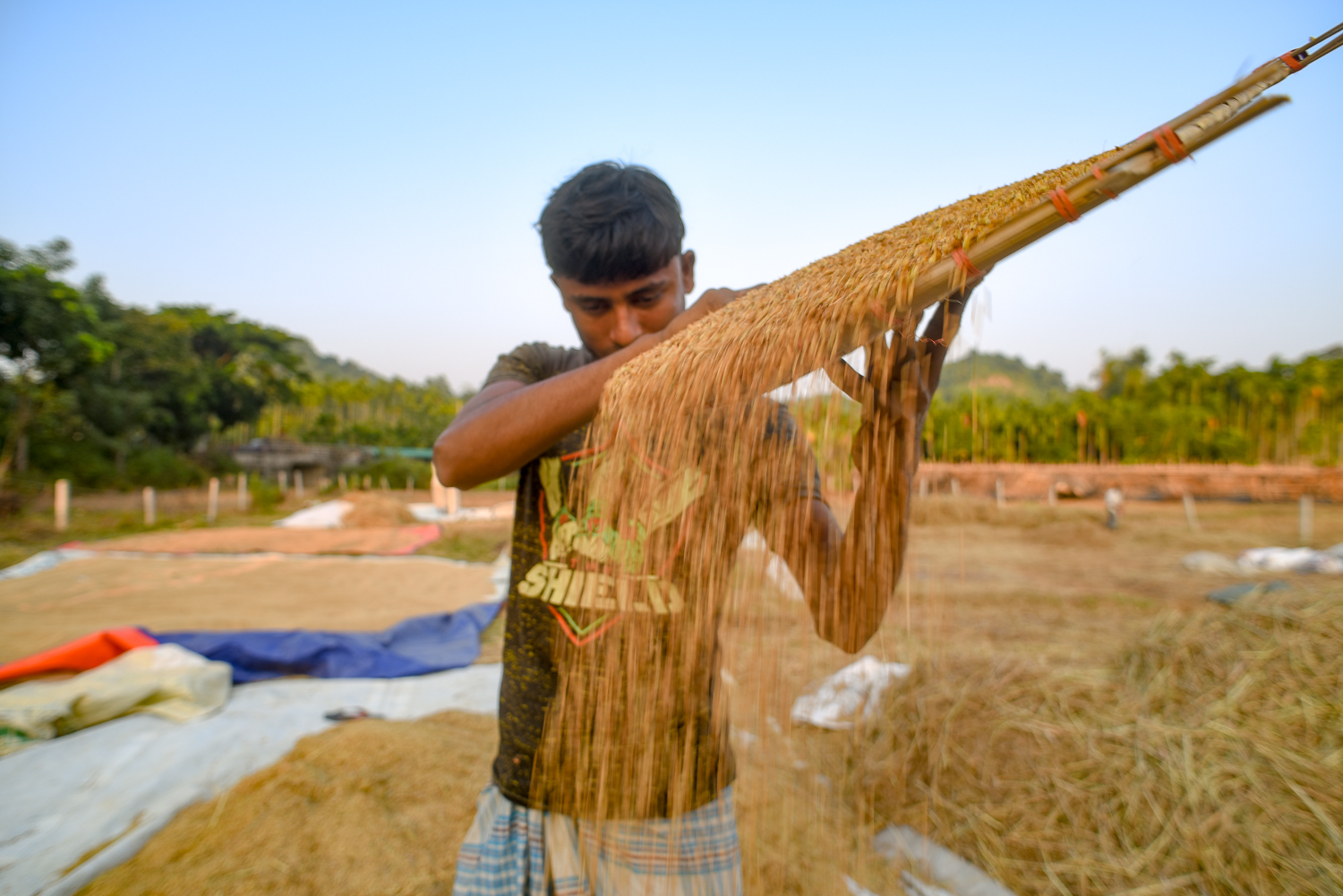
The Rohingya have limited opportunities to leave the densely overcrowded refugee camps. During the rice harvest, however, Rohingya are allowed by the local Bengali population—and the longer term, previously assimilated Rohingya refugees—to participate in the winnowing of the crops, sharing the labor to produce bushels of naked rice for storage or sale at market.
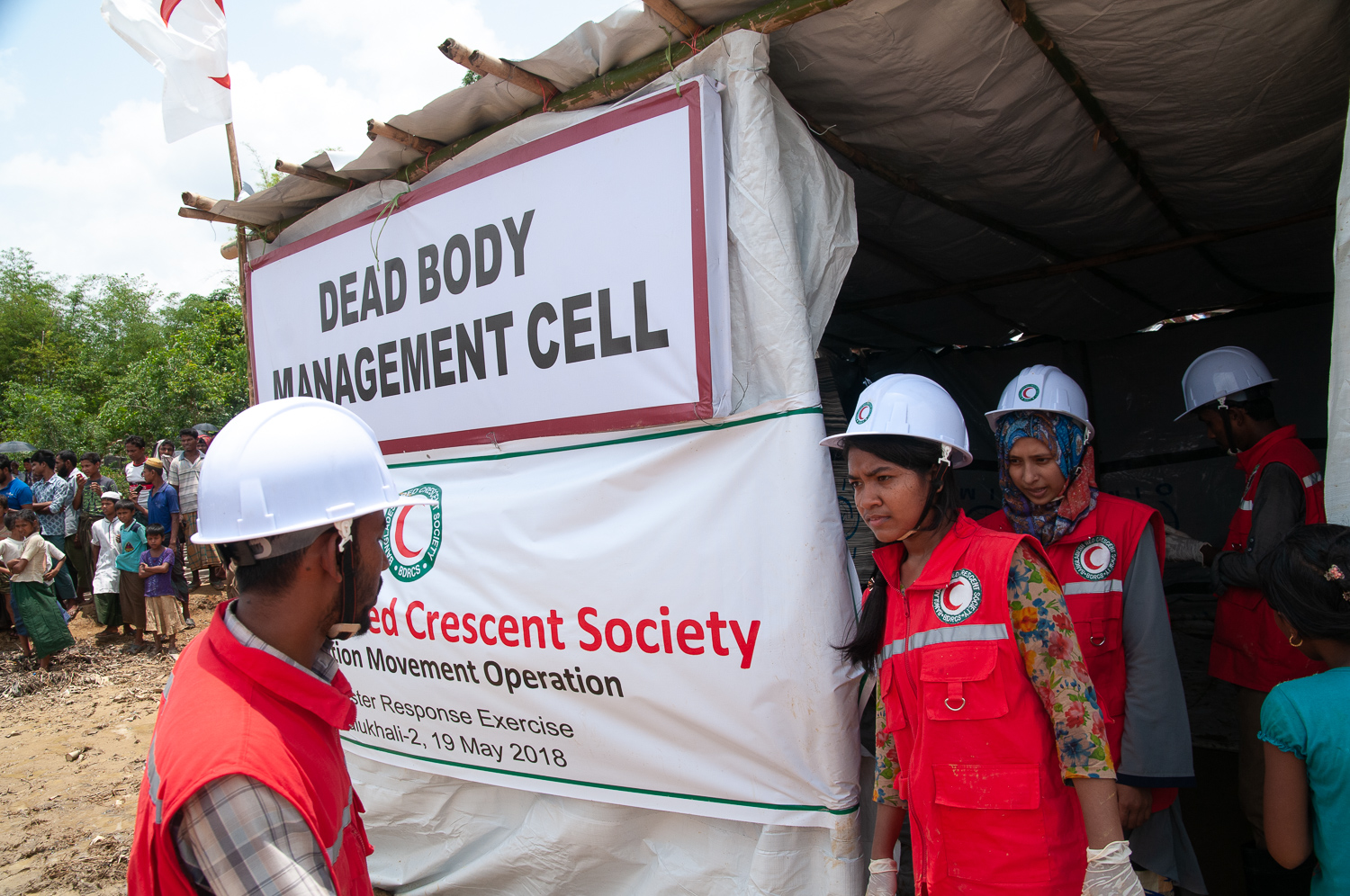
Rescuers trained in emergency response exit a non-government organization 'Dead Body Management Cell' erected and staffed for emergency preparedness in advance of Bangladesh's impending, deadly monsoon season.
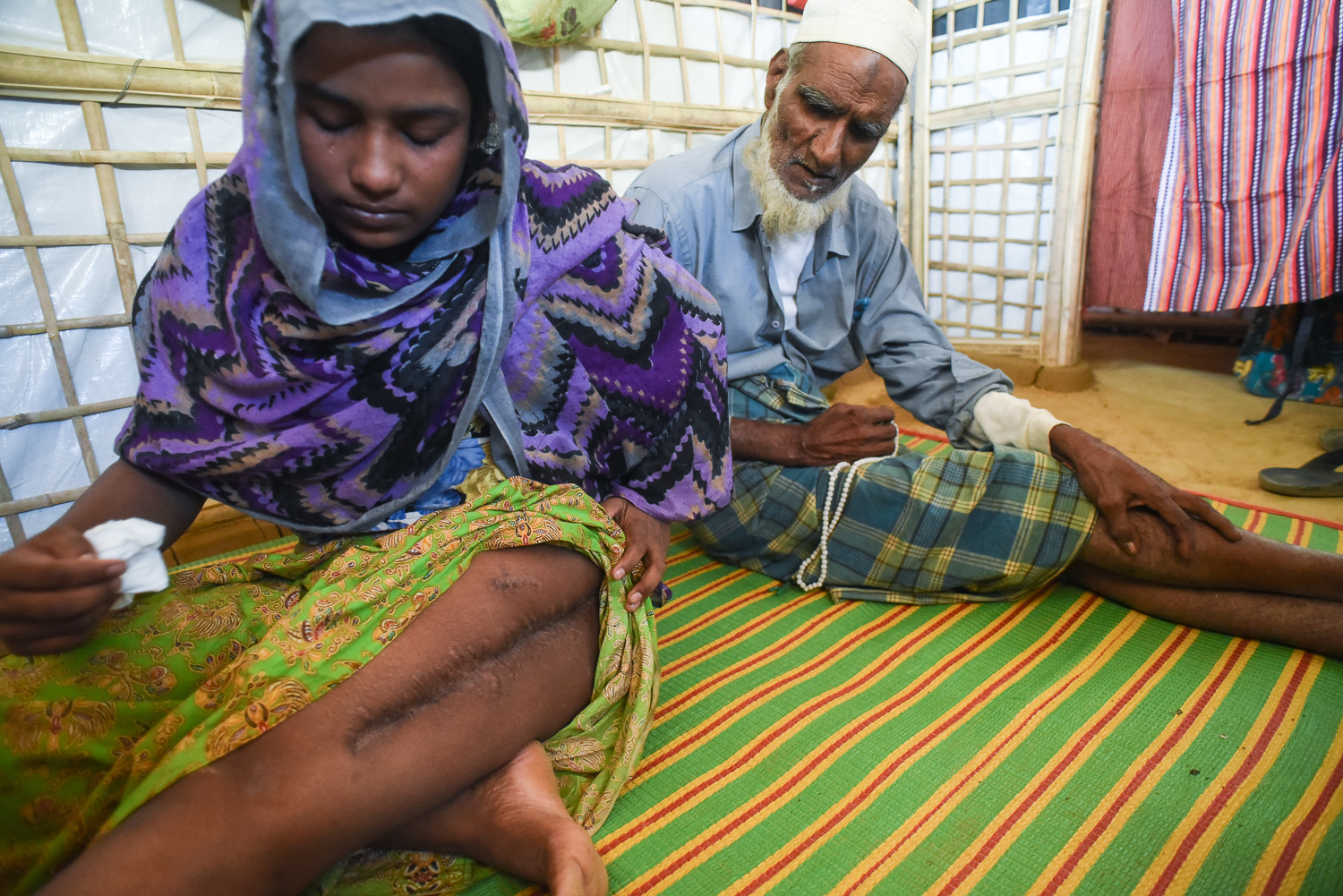
December 2019: A year and a half later, Khaleda Begem (now 17) shows the scar that remains after the large steel rods inserted in 2018 were removed. Her grandfather, Abubacar (80), looks on, commenting now and then. Khaleda Begem is feeling sick, her throat is swollen, her whole body in pain. her leg is healing, but one is shorter than the other one now. She walks with crutches, with a bad limp. "My life is destroyed," Khaled Begem declares. She daubs the tears off her cheeks with a tissue. "I'm a cripple because of Aung San Suu Kyi. I have no future. When I get older no one will be there to help me. No one has come to me for marriage though I am a virgin. If someone comes to arrange the marriage the man will refuse because I am broken with a scar on my leg because of the military."
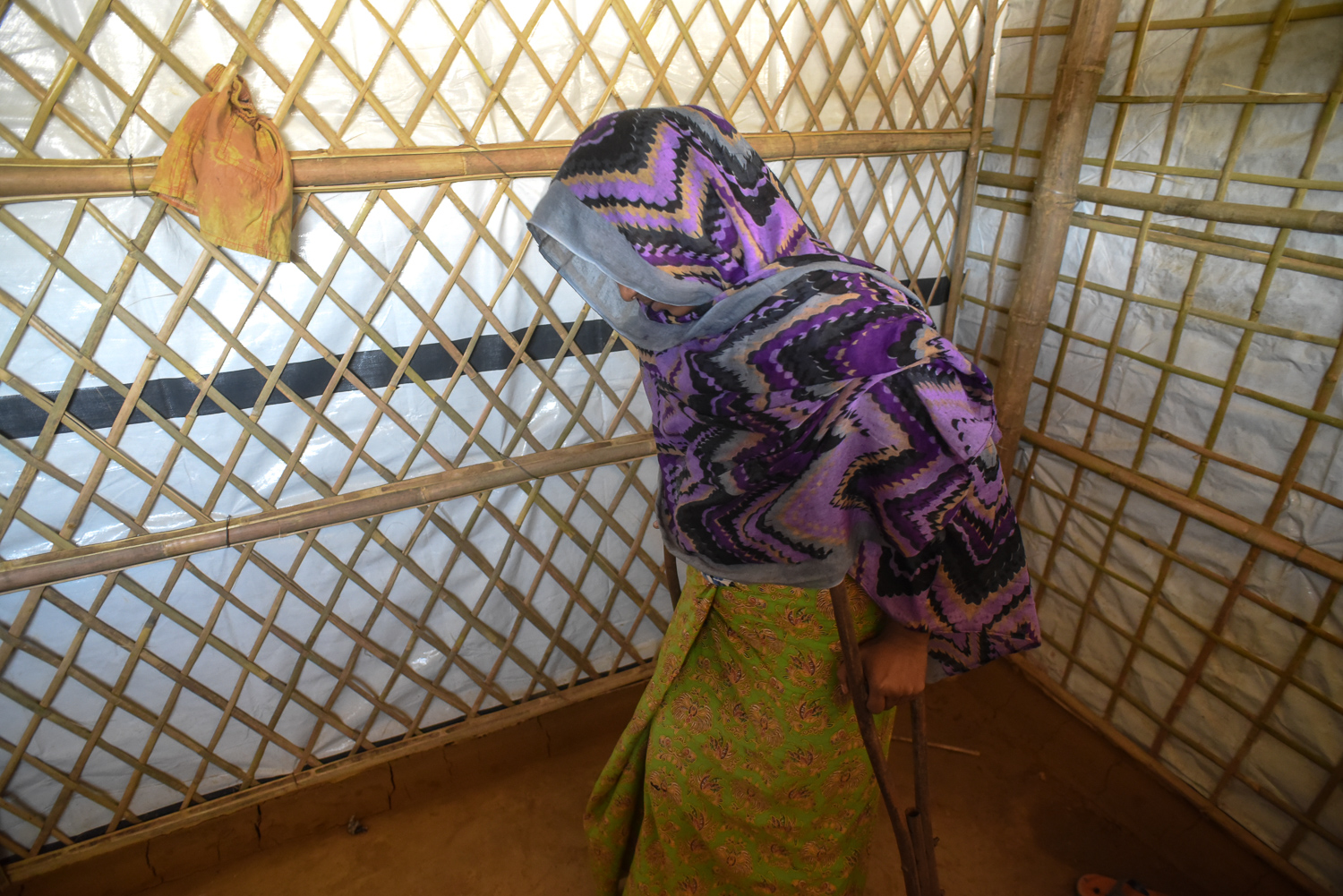
Khaleda Begem tries to walk using the crutches provided to her by a foreign medical NGO, but the pain is so great, and the sadness so great, that she begins sobbing and hides her face in her scarf. Tears begin to flow from her eyes, and she dabs them with a tissue, choking back sobs. After several minutes silence, her body shifting on the crutches, she tells more of her story. She has had four blood infusions. A year and a half ago they took out the steel rods. It's hard for her to move around, so she tries to exercise inside the tiny hut that she shares with her mother and her grandmother and a few children. The terrain outside the hut is steep, treacherous, often slippery, a virtual obstacle course for a healthy pedestrian, an extreme challenge for Khaleda Begem: worst is the embarrassment she feels, being "a cripple".
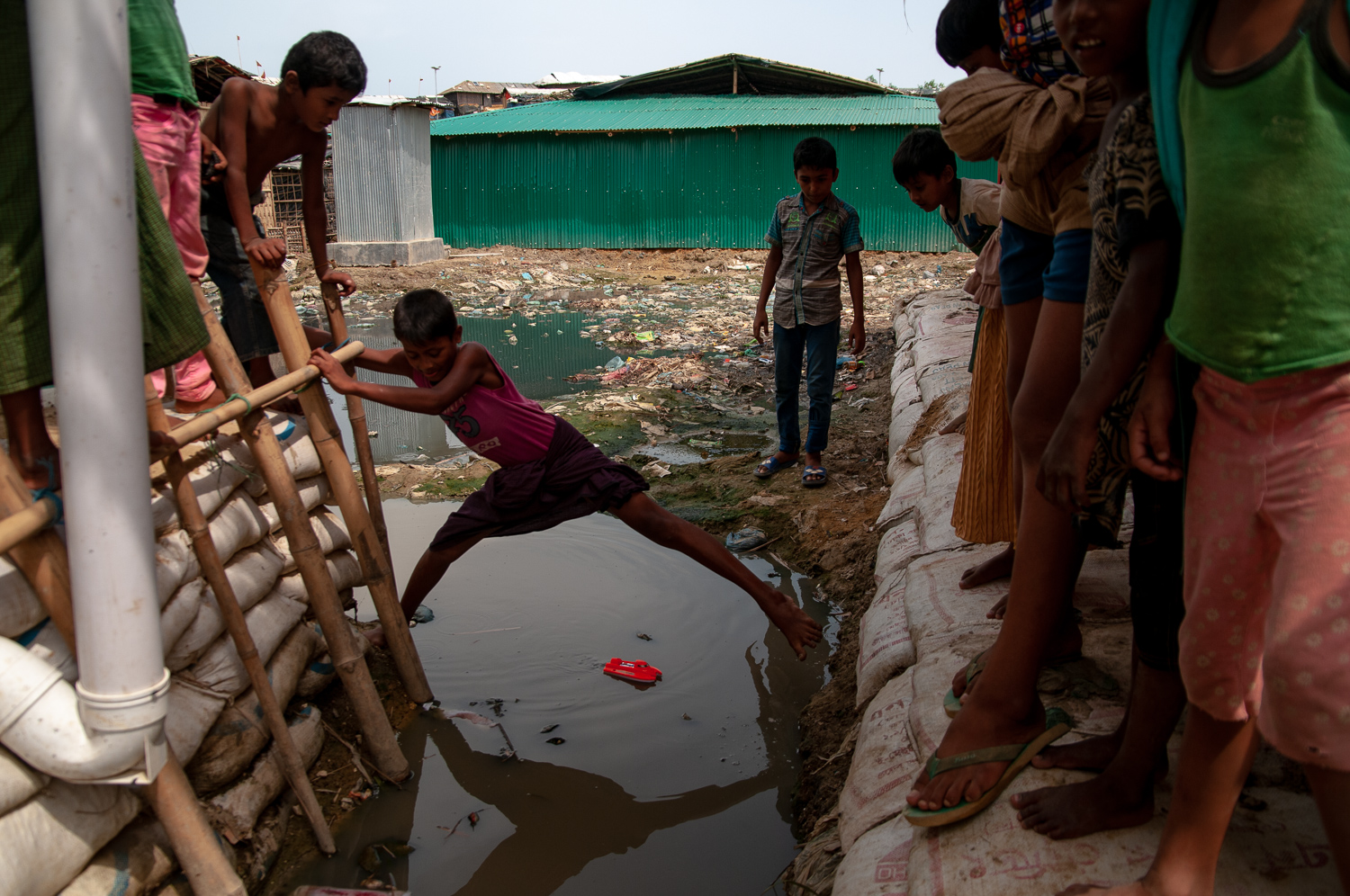
A boy is about to fall in the polluted water where Rohingya children play with an orange plastic boat toy—a rare possession—in a fouled 'stream' created by flooding after a heavy rain at the Balukhali II refugee camp. The stream is polluted with organic (human) brown water, chemicals, plastics and other wastes. There are limited options for children to play: an entire generation will grow up knowing only the life of a refugee in a camp like this.
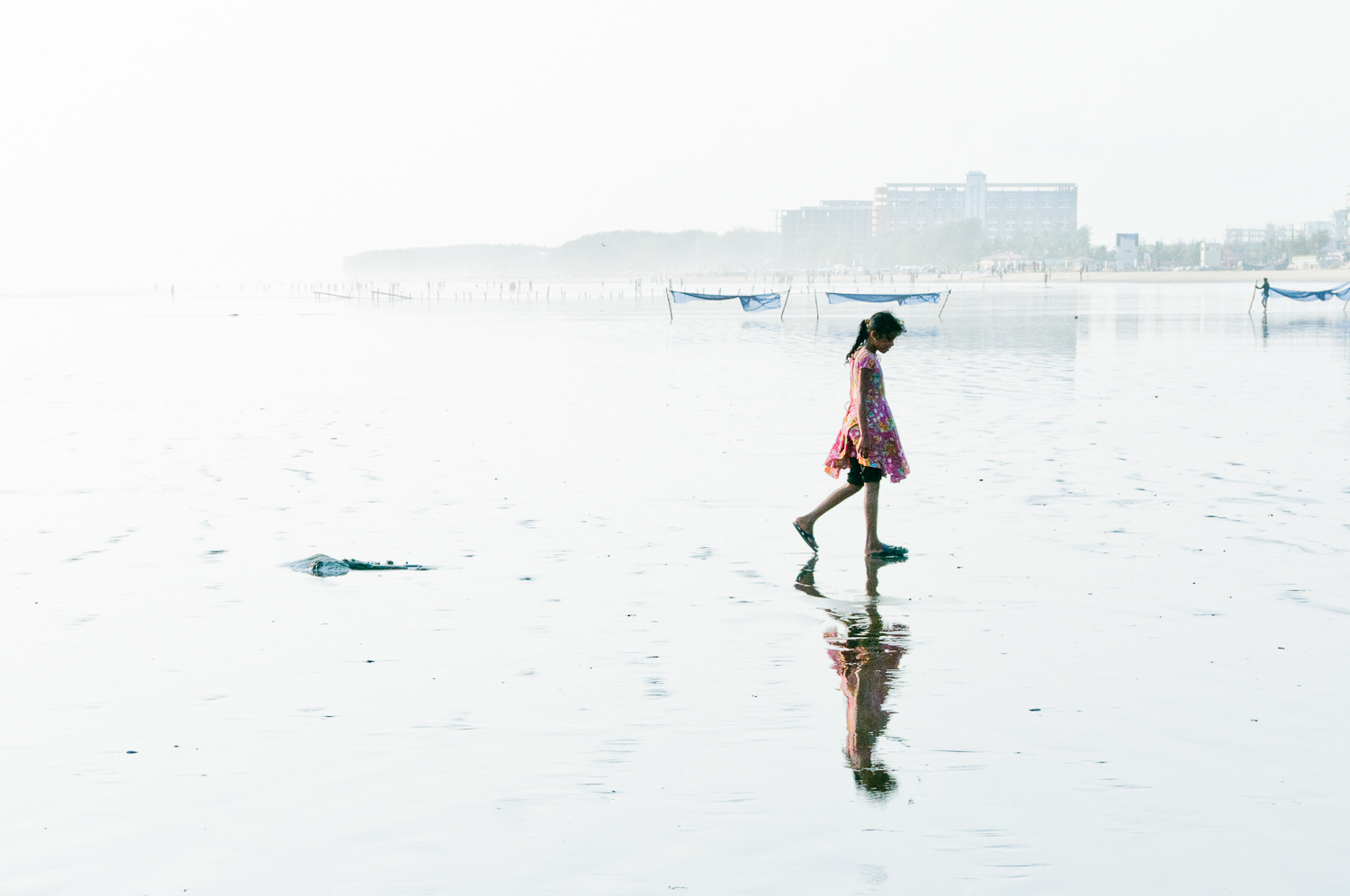
A Bengali girl walks the beach near the big hotels of the Cox's Bazaar city. Population density and land security were already problematic in the Cox's Bazaar and Tecnaf districts, and with the influx of almost 1 million Rohingya refugees has come multiple conflicts and struggles for power.
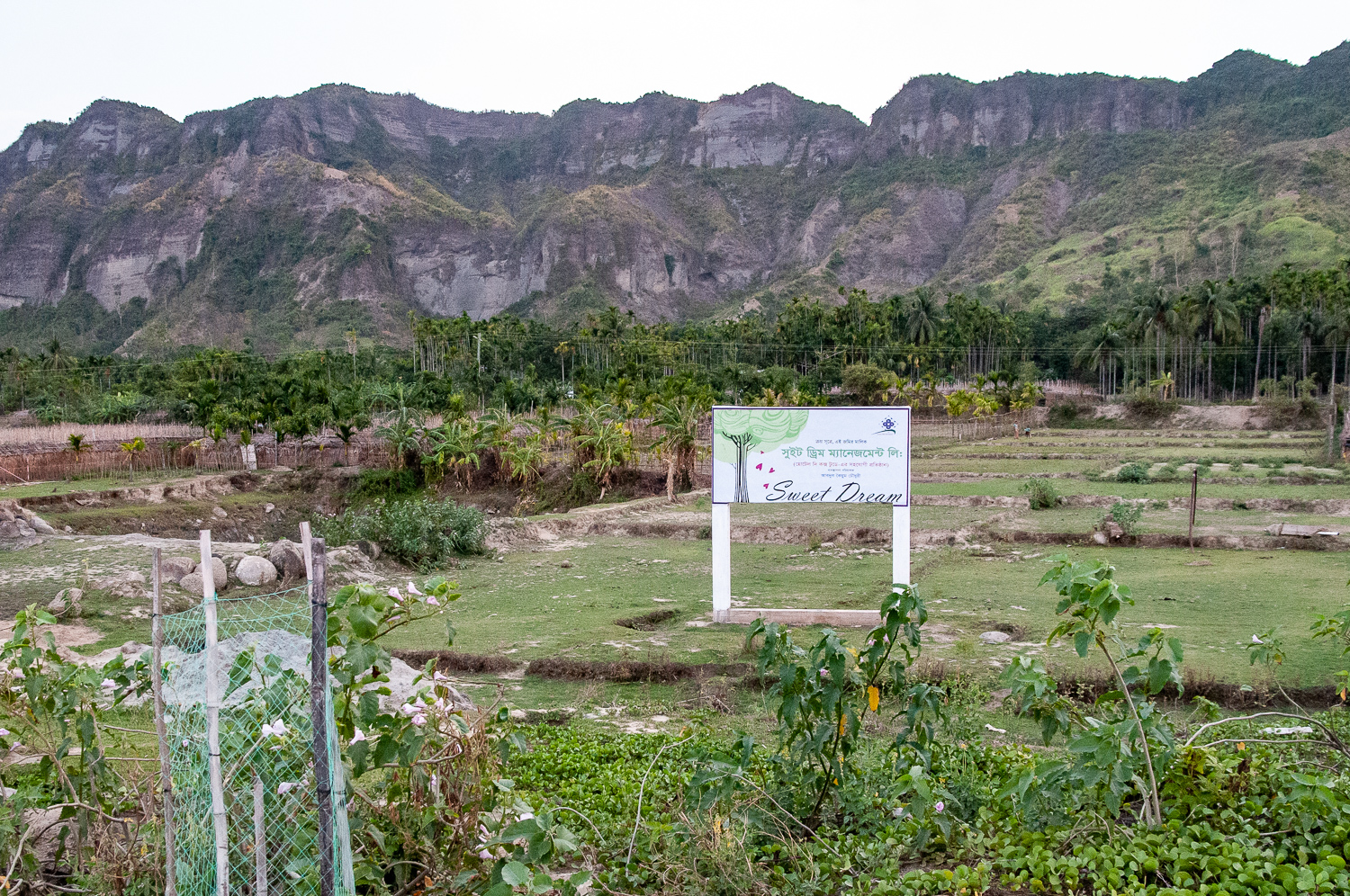
"Sweet Dream" reads a large billboard erected on a plot of real estate forcibly seized by a powerful land speculator from Dhaka. Land is premium in the Cox's Bazaar and Tecnaf districts of far eastern Bangladesh, near the Burma border, where the flood of refugees has overwhelmed the natural resource base and drastically altered the economic and cultural realities of life for millions of people. The poorer locals—both Bengalis and Rohingya who have long since been settled in the Tecnaf/Cox's Bazaar districts here—are often powerless in the face of real estate corruption and land theft. The billboard is declaring new private ownership of what has long been communal land belonging to indigenous people.
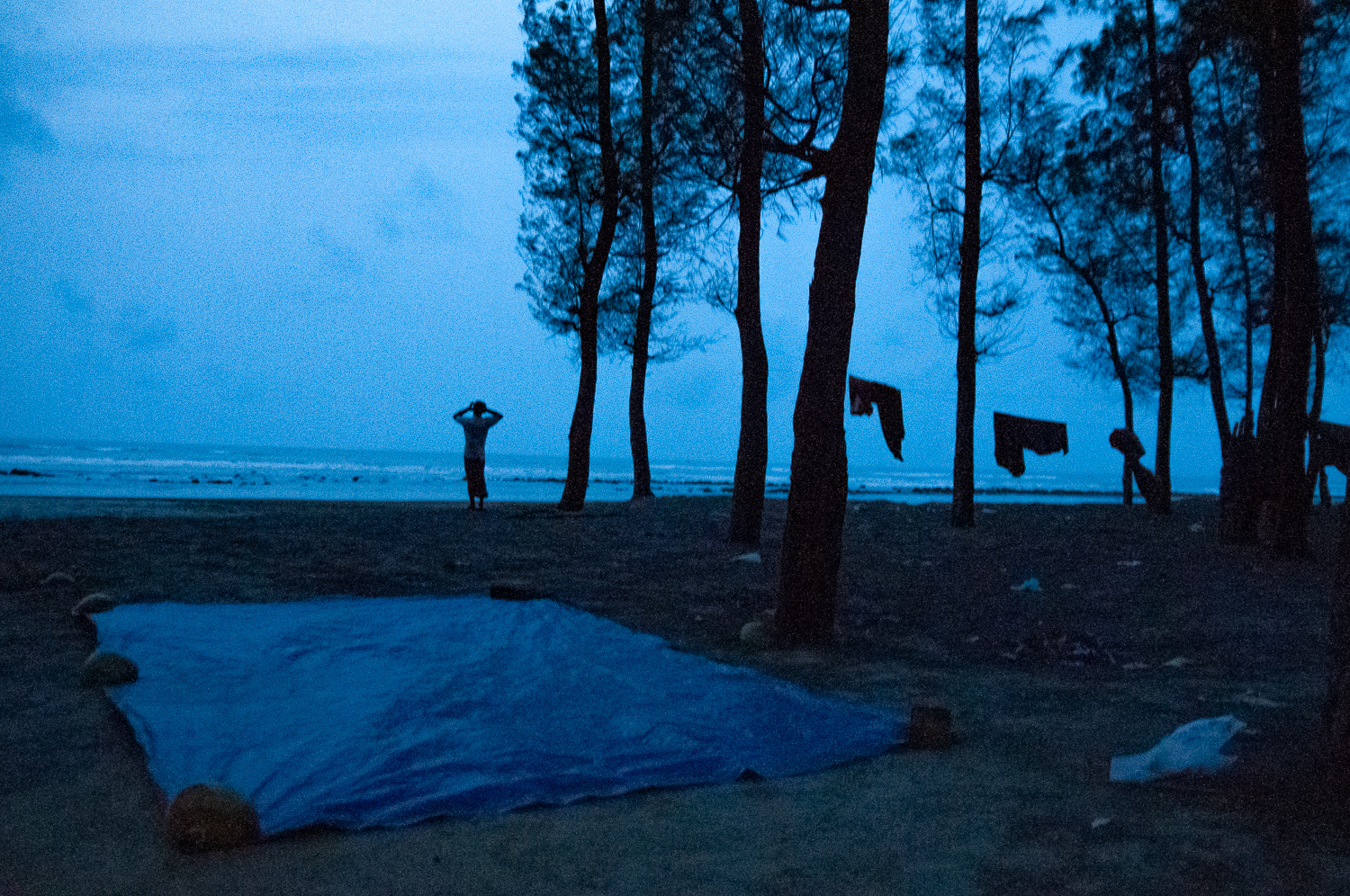
Waiting for others to join him to perform the early evening prayers (on a blue tarp he has spread out under the palm trees), a Rohingya man looks out over the sea, the Bay of Bengal, at sunset near Tecnaf, a district far south of the city of Cox's Bazaar. Many Rohingya who fled Burma years before the 2017 violence have effectively assimilated and put down roots amidst the local Bengali population up and down the coast here. The coastline of the Cox's Bazaar district offers the longest contiguous beach in the world, and the government of Bangladesh and big business tycoons have begun a ruthless development of the coastline for tourism. The Rohingya know that Rohingya people are being trafficked by profiteers, and suffer injustices, if not death, while making the sea journey out of Burma, or while trying to escape the hopeless aimless life of a Rohingya refugee trapped in the overcrowded camps.
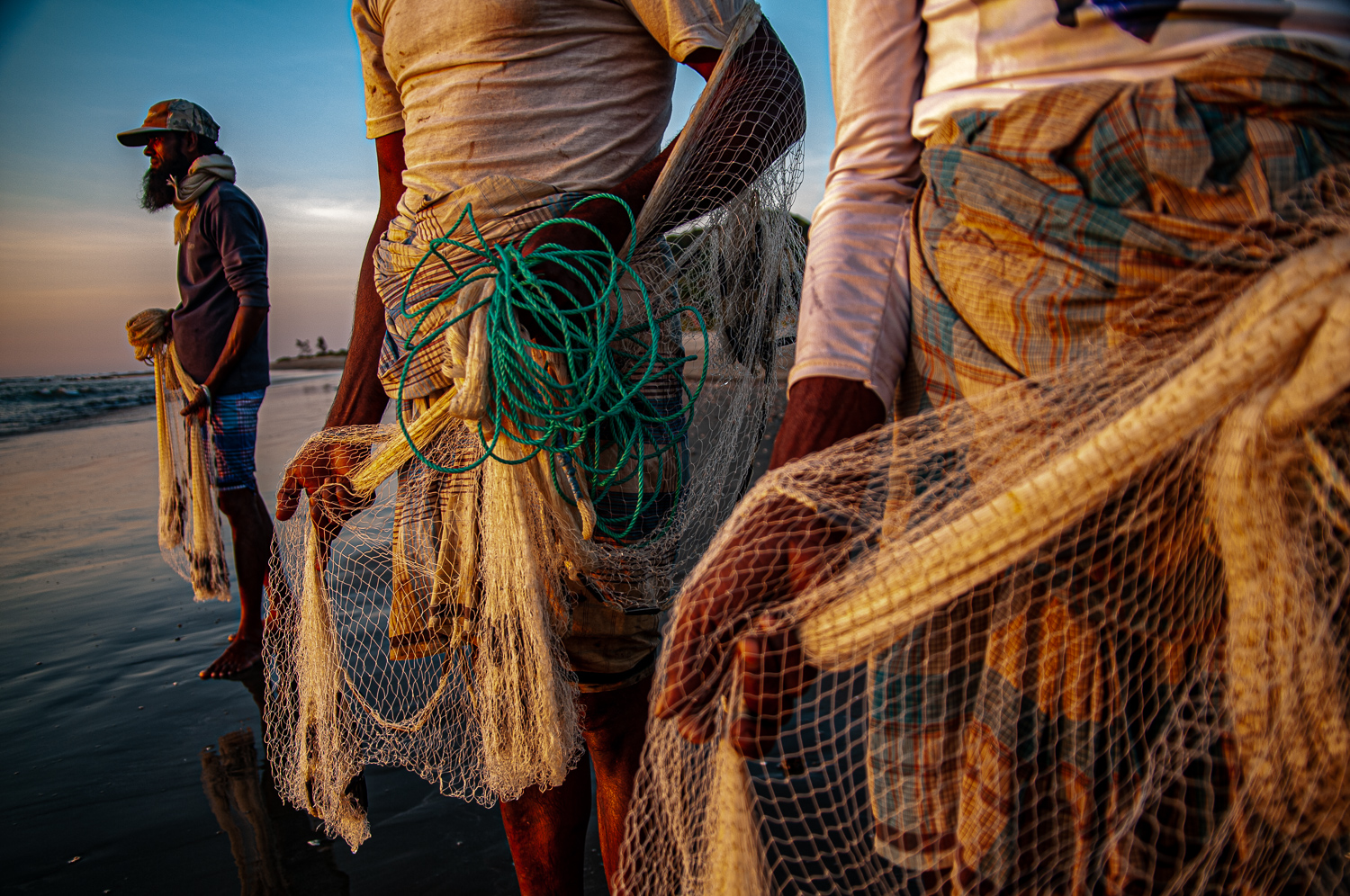
At sunset near Tecnaf, only a few miles from the sprawling refugee camps, indigenous Bengali fishermen stand vigilantly watching the waves for the silver flash of schools of fish driven into the shallow tidal flats by larger fish on the hunt. Fish are a premium food for hungry refugees, and the competition for fish and fishing is fierce amongst the local population and the refugees.
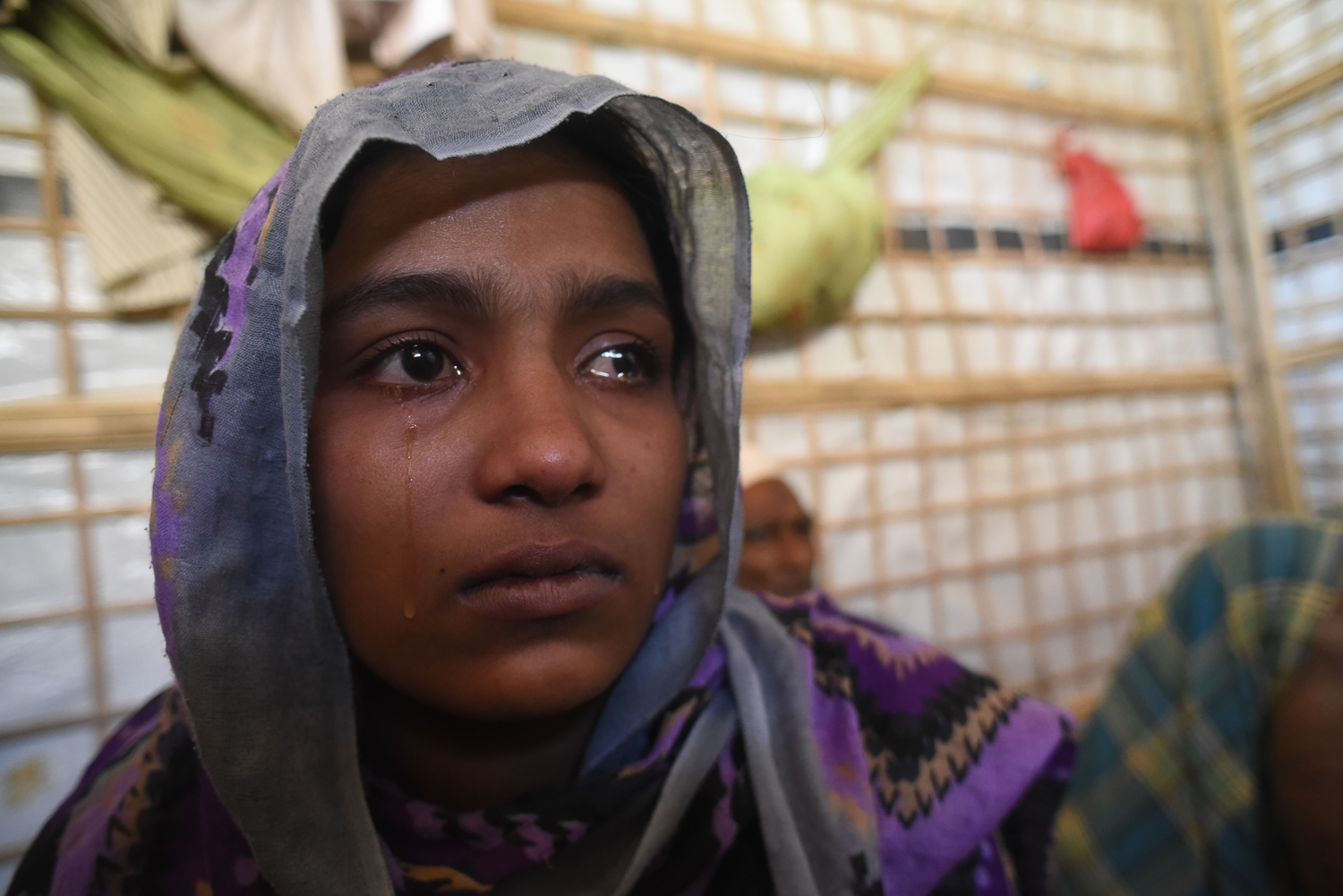
2 December, 2019: It is only a few days before Burma's leading lady Aung San Suu Kyi is scheduled to appear at the International Criminal Court to mount a defense for the military government, challenging the accusations of genocide, and Khaleda Begem wants Aung San Suu Kyi to hear her. If she could speak to Aung San Suu Kyi, Khaleda Begem would ask her: "What have we [Rohingya] done? What was our mistake? What have I done?" "My life is destroyed," Khaleda Begem stifles a sob. "I have no father [he died when she was small]. I'm sick, and there is no one to support us. I had many dreams what I was going to do with my life. I was so happy—before this [injury]. I was living with joy. I expected my life would be a good one. My dream is ruined."
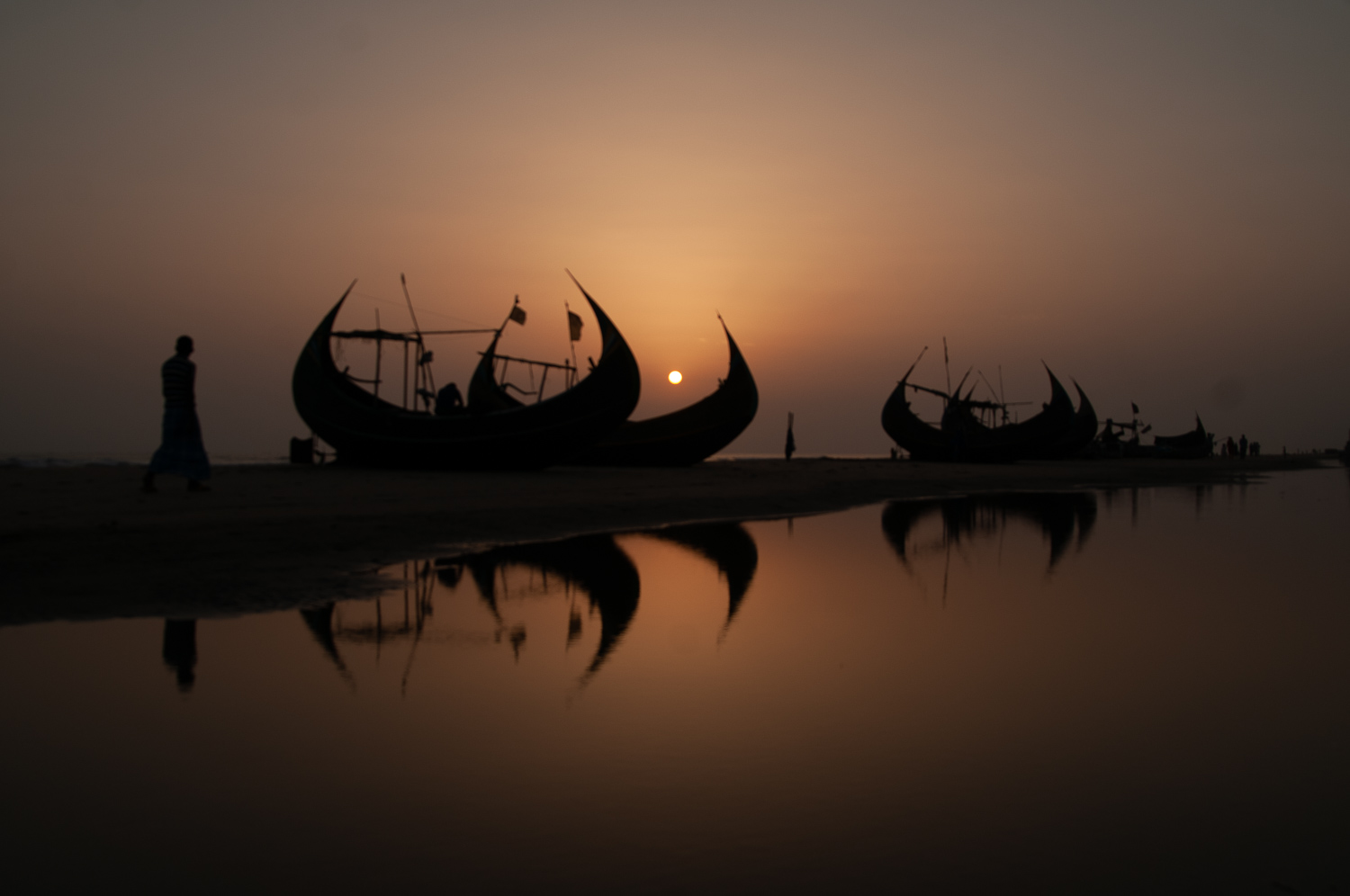
Another day, another sunset, half way down the coast from Cox's Bazaar to Tecnaf, just a few miles west of the Rohingya refugee camps. Boats like these built by the resident indigenous peoples—including Rohingya who have long since assimilated into this area of Bangladesh—are sometimes used to rescue Rohungya refugees, get them out of Burma to Bangladesh across the Naf River; but sometimes they are used to traffic Rohingyas for the sex trade, or purely to extort money from them, preying on their desperation and their entrapment y the Burmese military and their subsequent flight in search of security, freedom and survival.